Stone fireplaces offer a timeless blend of texture, warmth, and architectural interest, with designs ranging from rustic fieldstone hearths to sleek, contemporary mantellines. Whether you’re drawing inspiration from grand floor-to-ceiling installations, minimalist black-stone surrounds, or versatile outdoor fireplaces, there are creative solutions to complement any décor and budget. Key trends include the use of natural stone veneers for lightweight installations, cultured stone refacing for cost-effective updates, and combinations of stone with wood or metal accents for dynamic contrasts. Outdoor stacked-stone designs and double-sided fireplaces further expand living spaces, blurring the line between indoors and out.
1. Floor-to-Ceiling Stone Fireplace
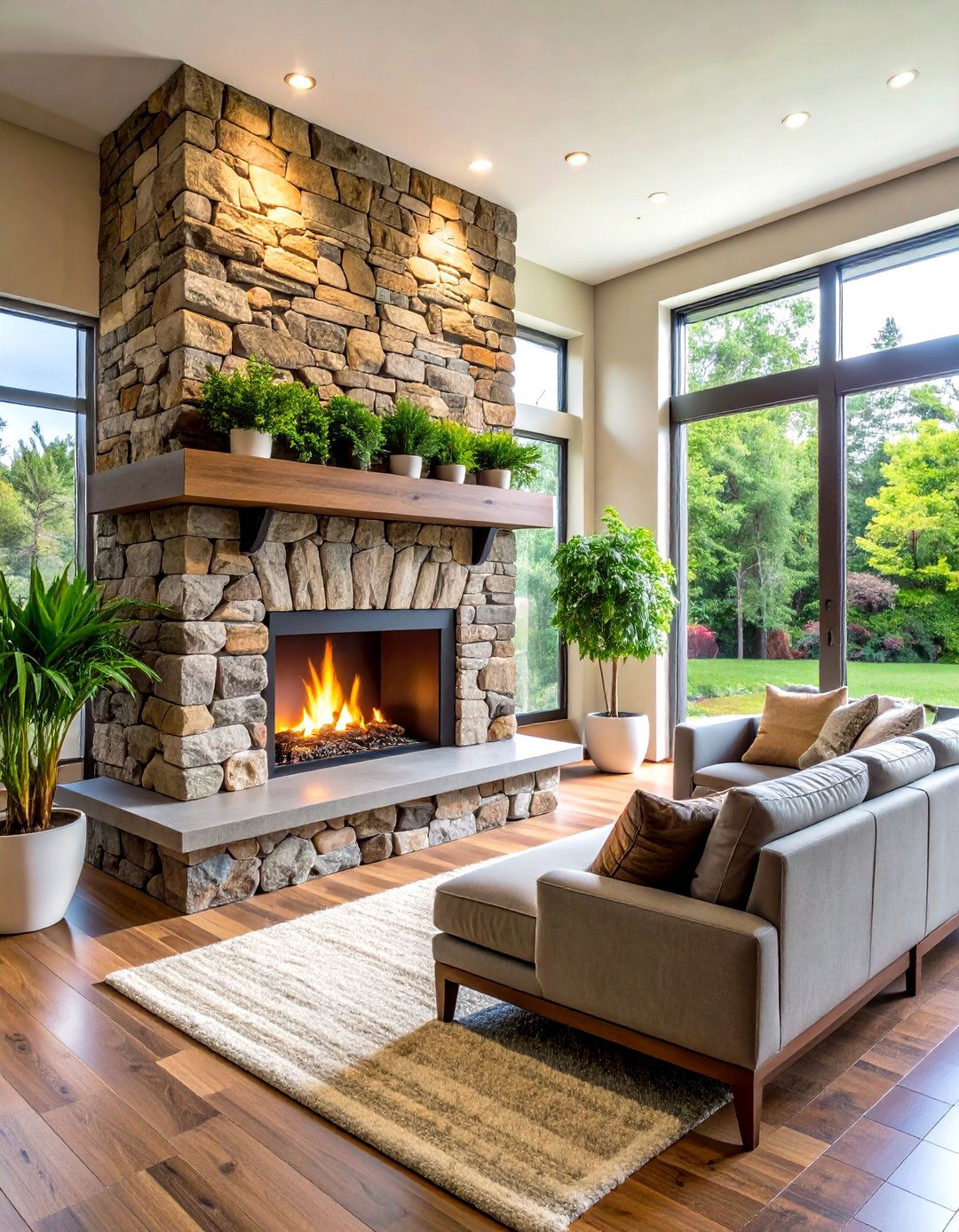
A floor-to-ceiling stone fireplace transforms a living room into a lodge-inspired retreat by extending the stone facade from hearth to ceiling. This design often features an off-center hearth to create visual interest, with stones meticulously stacked to emphasize natural variations in color and texture. The absence of a traditional mantel accentuates the raw beauty of the stone, while built-in ledges can display artwork or greenery, integrating décor seamlessly into the hearth. Ideal for open-plan spaces, this approach anchors the room and enhances the verticality of high ceilings, making it a dramatic centerpiece in both modern and rustic interiors.
2. Rustic Fieldstone Hearth
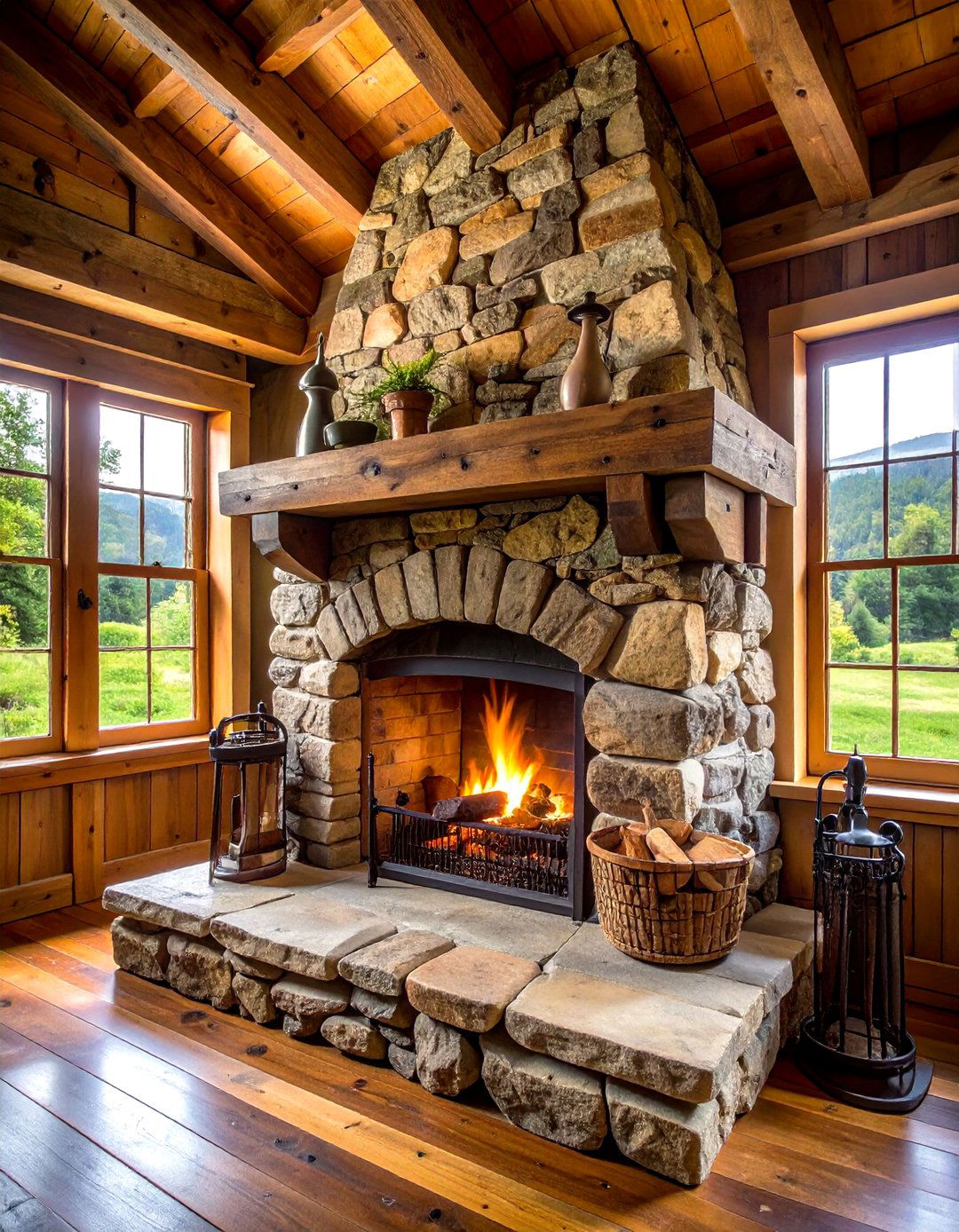
Rustic fieldstone fireplaces celebrate irregular shapes and earthy hues, evoking cozy countryside aesthetics. Stones are often left in their natural state, with uneven surfaces that capture light and shadow, adding depth and character. This style suits cabins and farmhouses, especially when paired with reclaimed wood mantels or driftwood accents, reinforcing a handcrafted feel. Fieldstone’s rugged appearance also conceals soot and wear, making it low-maintenance for busy households. For an enhanced rustic vibe, incorporate wrought-iron tools and a wood storage niche built directly into the stonework, creating a functional display that complements the hearth’s organic form.
3. Cultured Stone Reface
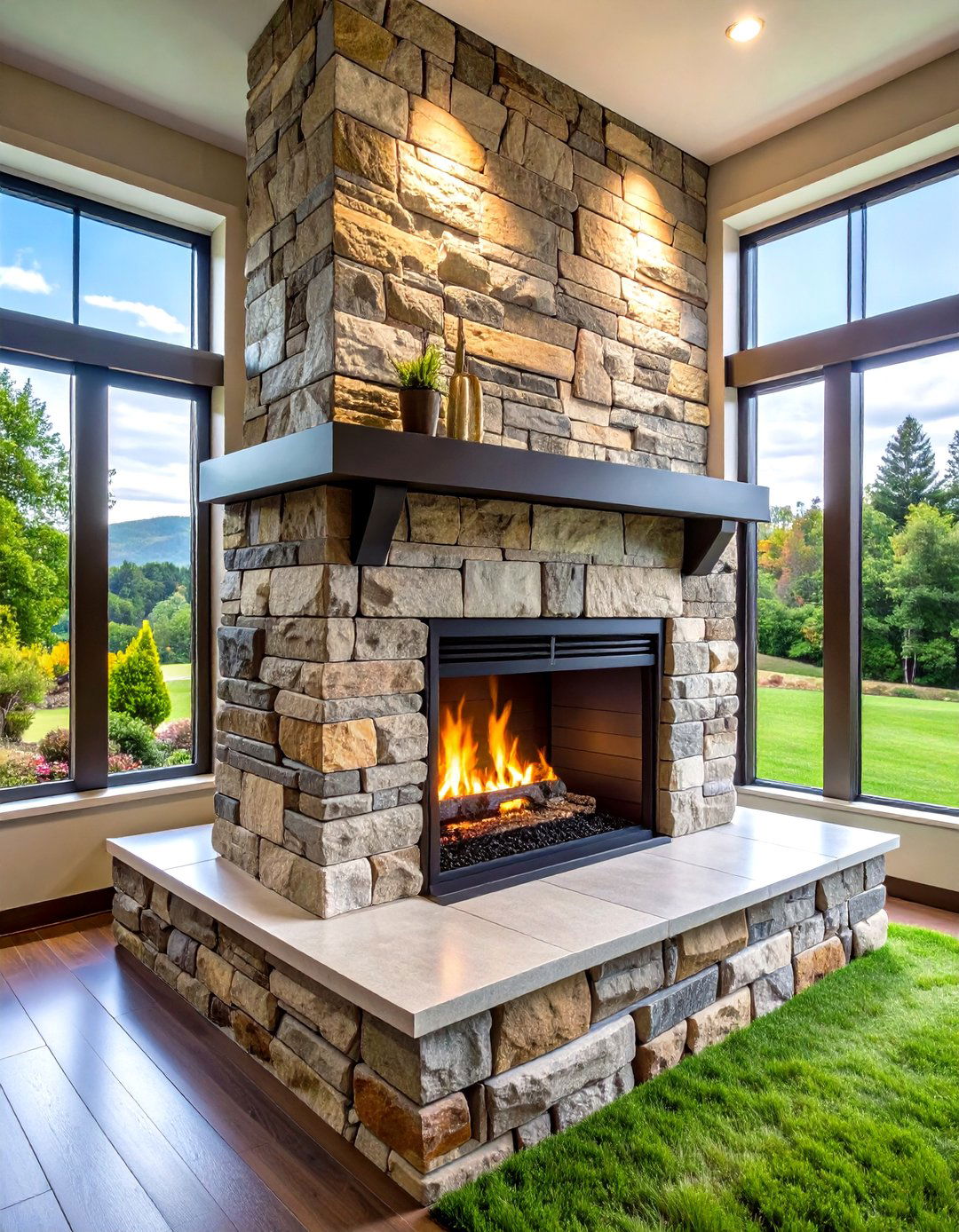
Refacing an existing brick or dated surround with cultured stone offers a cost-effective method to achieve authentic stone aesthetics. Homeowners attach a wire mesh base over the old surface and then apply mortar and lightweight cultured stones, which come in various textures and colors. This approach minimizes demolition and waste, delivering a fresh, durable finish that mimics natural stone. Cultured stone is available in both rough-cut profiles for rustic looks and smoother options for traditional designs. DIY-friendly guides detail layout planning using paper templates to ensure balanced stone placement around the hearth, making it accessible for ambitious renovators.
4. Sleek Slate Surround
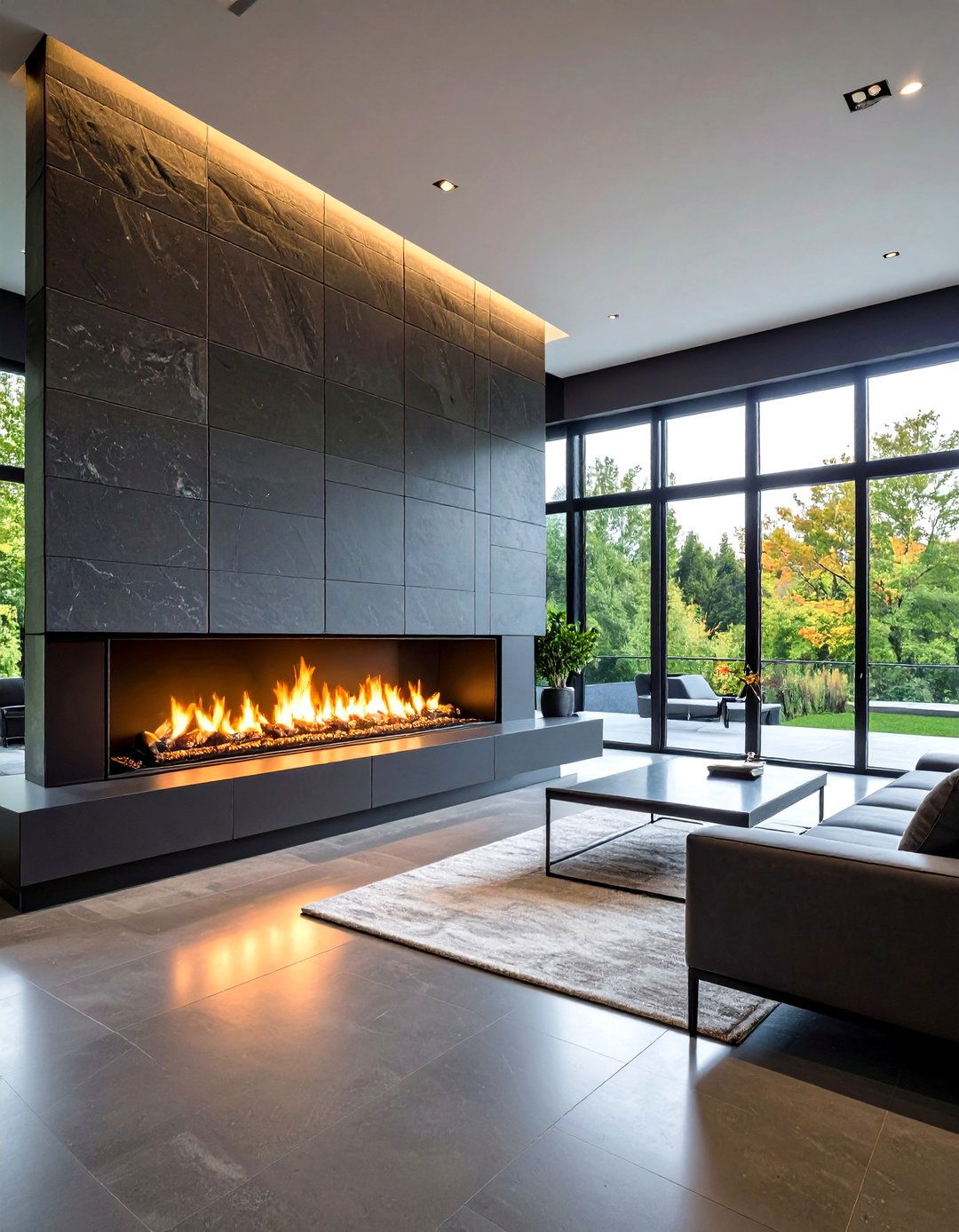
Slate surrounds offer a modern twist on stone fireplaces, featuring thin, uniform panels that create a minimalist, geometric aesthetic. The slate’s fine grain and deep, uniform color palette—from charcoal to midnight blue—provide a striking backdrop for both wood-burning and gas inserts. Slate is naturally heat-resistant, ensuring durability and safety, but its smooth surface requires an oil-based sealant to protect against stains and scratches. When paired with linear gas fireplaces, slate emphasizes clean lines and contemporary finishes, making it a preferred choice for minimalist or industrial-inspired interiors seeking a sophisticated focal point.
5. Limestone Hearth
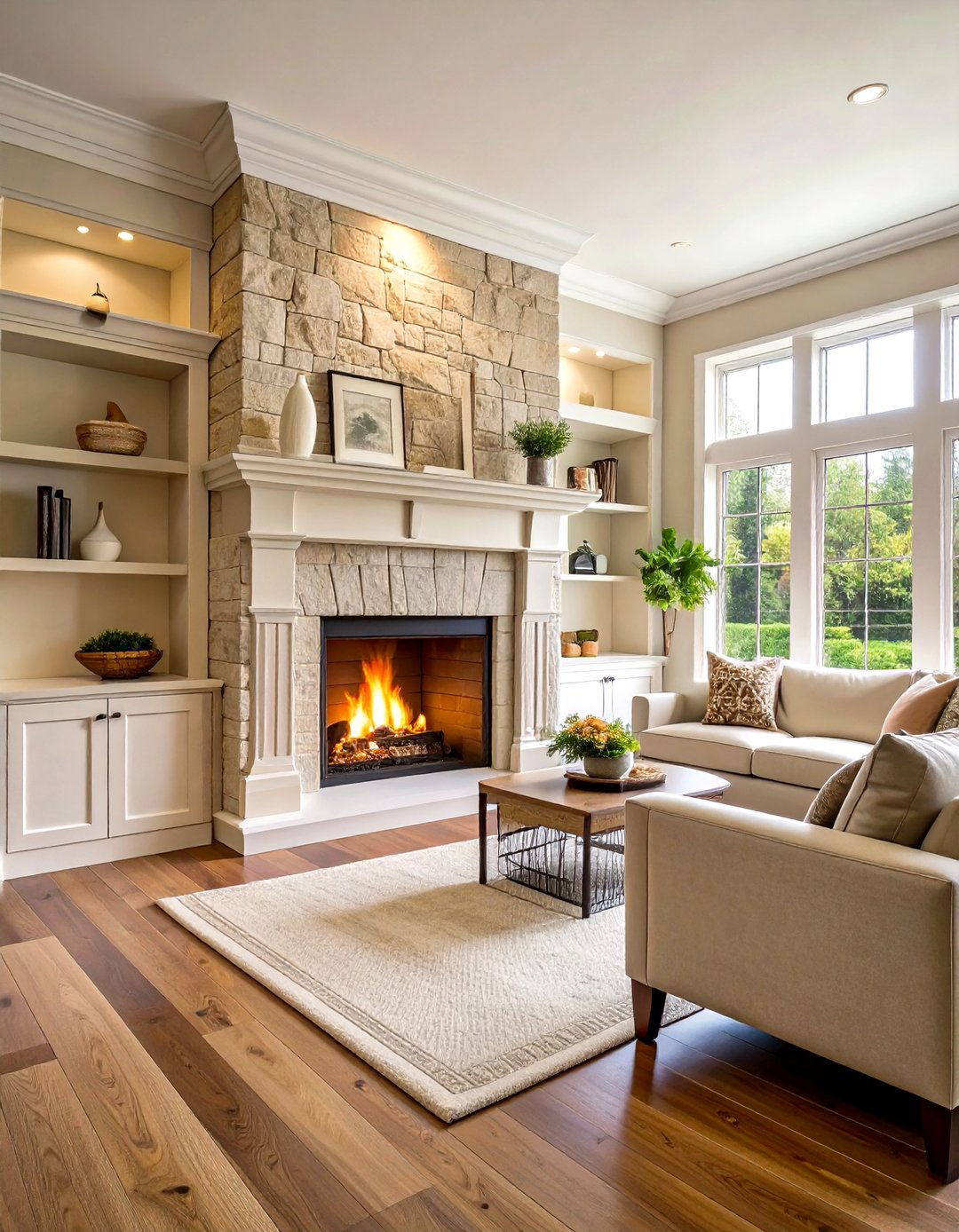
Limestone offers a softer, neutral-toned alternative to darker stones, with its warm beige and cream hues creating an inviting atmosphere. Its fine texture allows for precise carving, lending itself to detailed mantel designs and integrated shelving niches. Although limestone needs sealing to protect against staining and is not recommended for wood-burning fireplaces due to heat expansion, it excels in gas or electric installations where temperatures remain moderate. A limestone fireplace can seamlessly blend with light hardwood floors and pale wall treatments, brightening the room while maintaining a sense of timeless elegance.
6. Modern Minimalist Black Stone
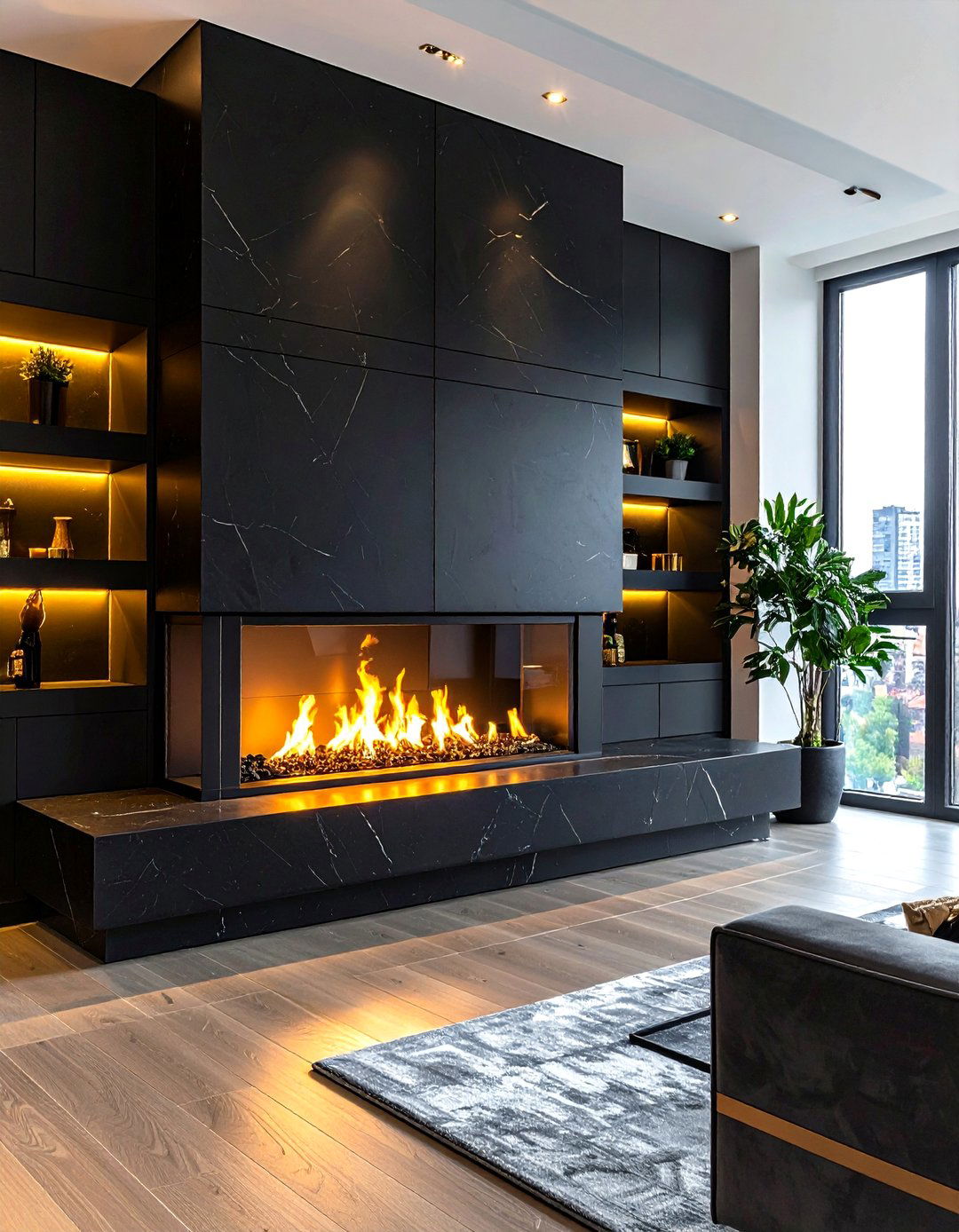
Contemporary designs often employ black or dark-gray stone surrounds to achieve a sleek, minimalist look. Ina Garten’s moody mantel, featuring a white mantel atop a black stone hearth, exemplifies how monochromatic contrasts can heighten cozy ambience without visual clutter. Dark stone panels emphasize the flicker of flames, drawing the eye to the hearth as a centerpiece. Pairing black stone with streamlined mantels or floating shelves enhances the clean-lined look, while gold or metallic accents—such as candlesticks or mirror frames—add a touch of luxury to the restrained palette.
7. Stone Veneer Accent Wall
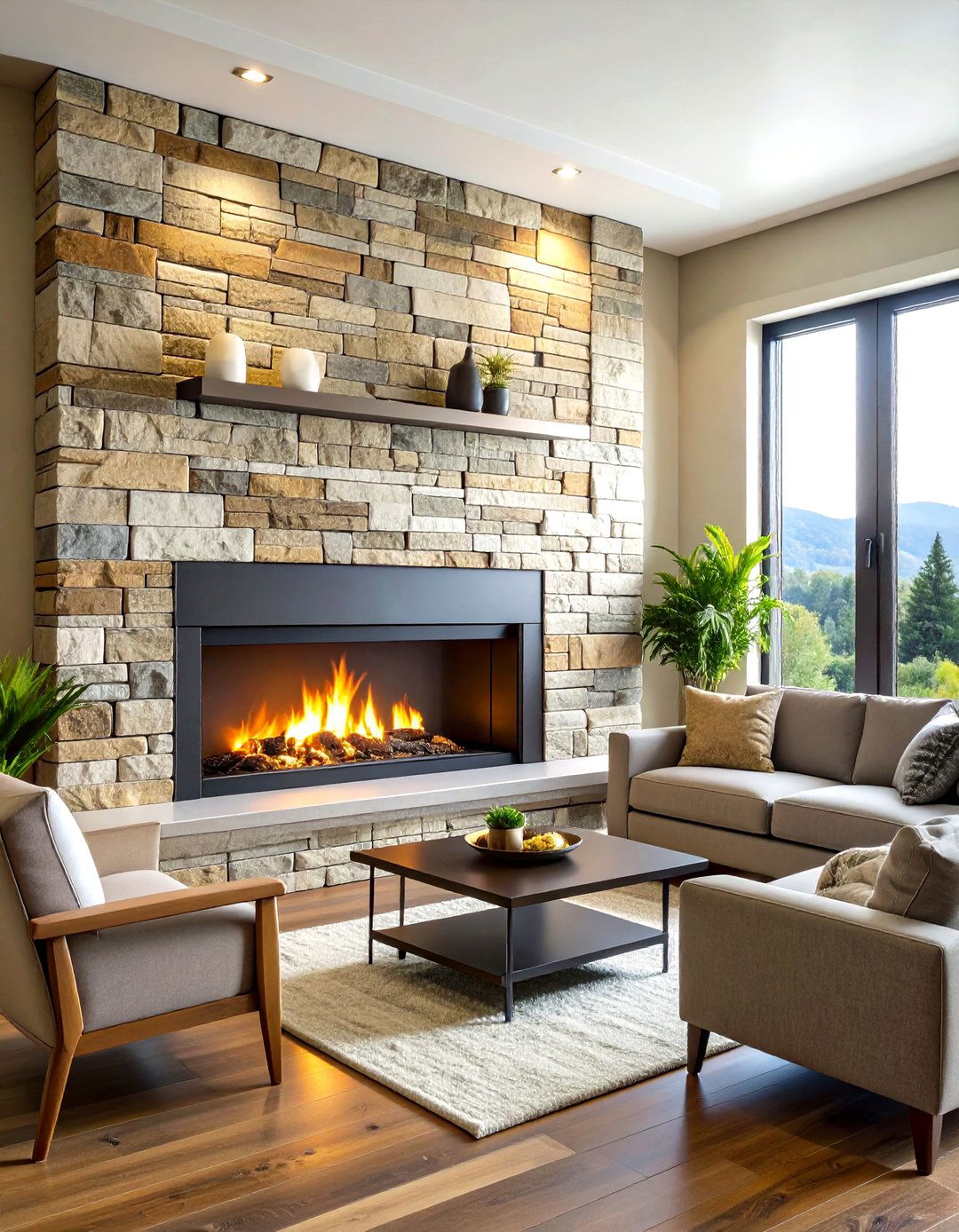
Stone veneers—thin slices of natural or manufactured stone—provide lightweight, affordable options for full accent walls or fireplace surrounds. Veneers like ledgestone, riverstone, and fieldstone adhere directly to drywall or plywood substrates, requiring minimal structural reinforcement. They mimic the look of full-thickness stone while reducing installation time and cost. Veneer panels can cover expansive walls, integrating the fireplace into a larger design narrative, or frame gas inserts in compact living rooms. With various textures and colors available, homeowners can customize the stone’s tone to match any décor style, from rustic to urban chic.
8. Outdoor Stacked-Stone Fireplace

Extending stone fireplaces beyond four walls, stacked-stone outdoor designs create year-round gathering spots in backyards and patios. Builders set stones on a concrete foundation and use cement board backing for long-term durability, while mortar locks stones in place to withstand weather elements. These fireplaces can incorporate wood or gas fireboxes, depending on preference and local codes. Adding seating ledges or integrated planters around the base enhances functionality and visual appeal. Complementary landscaping—such as pavers or gravel patios—rounds out the hearth area, inviting family and friends to enjoy outdoor fireside relaxation.
9. Riverstone Fireplace
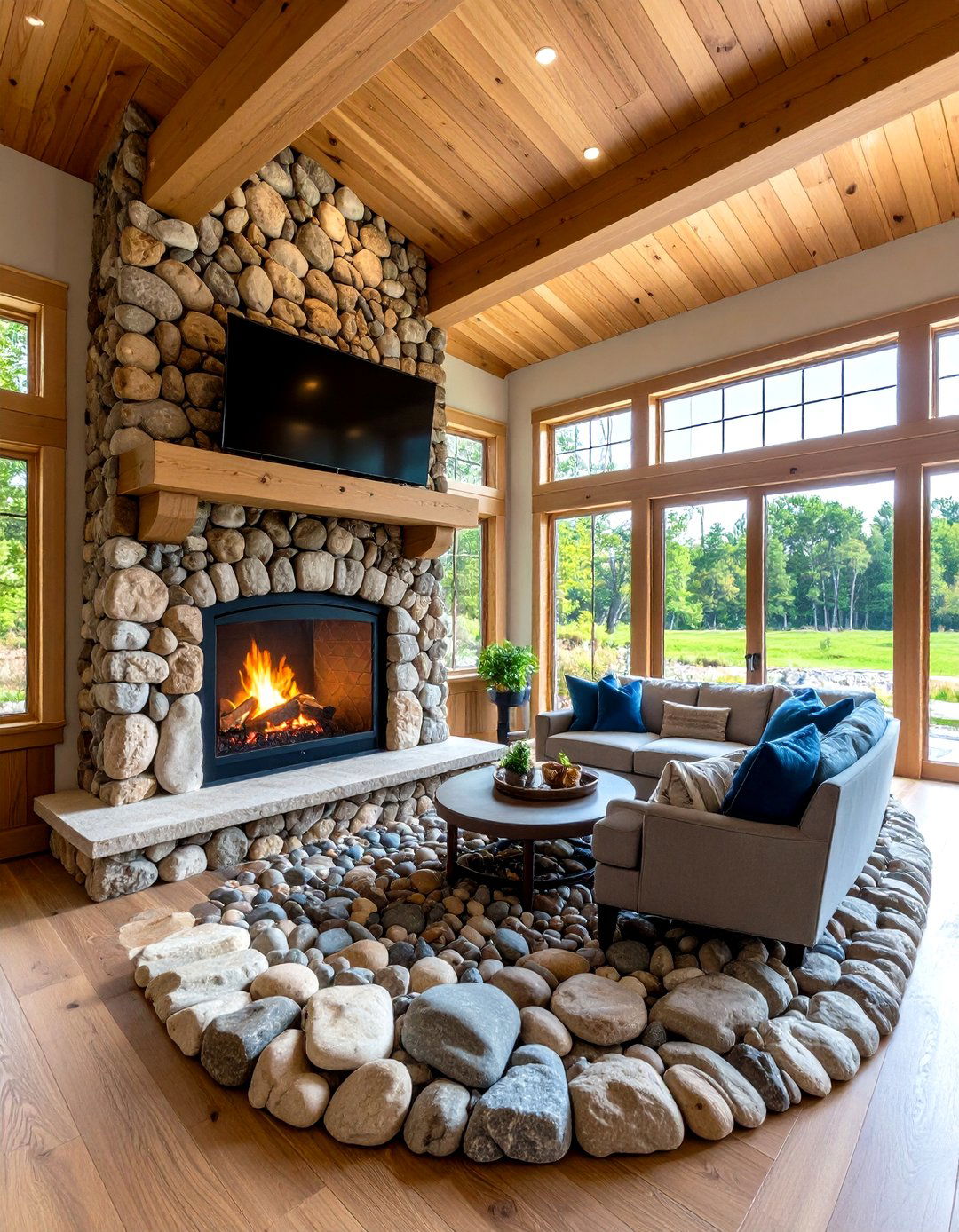
Riverstone fireplaces feature rounded, smooth stones sourced from riverbeds, offering a softer, more organic aesthetic compared to angular fieldstone. The tactile quality of riverstone, with its gentle curves and varied hues, creates a calming focal point suited to coastal or rustic interiors. Due to their irregular shapes, riverstones are often set in grout rather than traditional mortar, showcasing the natural stone edges and highlighting each piece’s individuality. A riverstone hearth pairs beautifully with light wood beams or wicker accents, reinforcing a nature-inspired decor scheme.
10. Double-Sided Indoor-Outdoor Fireplace
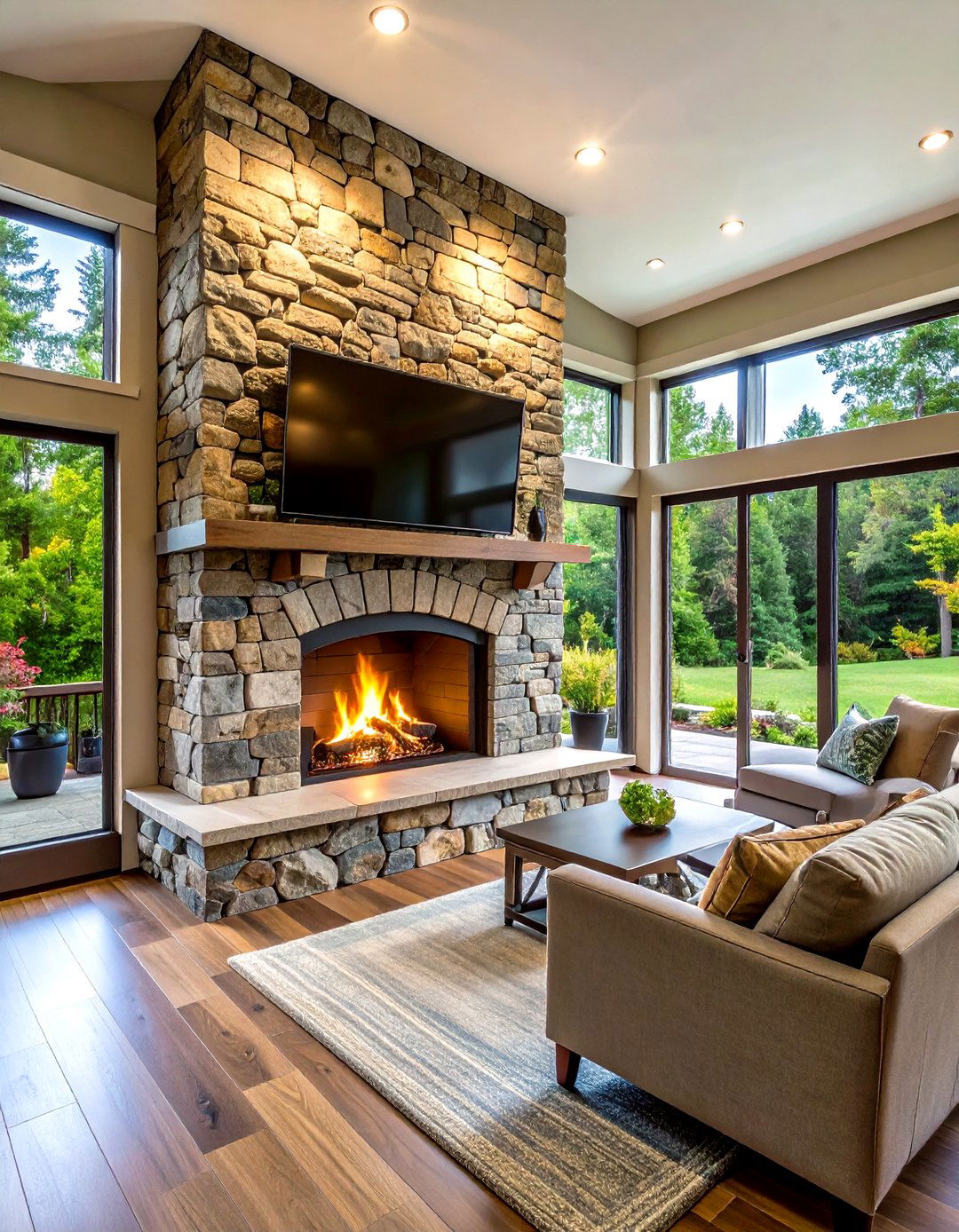
Double-sided stone fireplaces act as visual and functional bridges between indoor living rooms and outdoor patios. Constructed with fire-rated materials and proper ventilation, these installations offer warmth and ambiance on both sides, creating seamless transitions between spaces. Often framed in stacked or ledgestone veneer, the structure can anchor open-plan living areas, with floor-to-ceiling stone flanking either side. Glass doors or screens allow safe viewing and contain sparks. Incorporating seating alcoves on both faces maximizes usability, turning the fireplace into a sculptural centerpiece that unites two entertaining zones.
11. Corner Stone Fireplace

Corner fireplaces maximize space in smaller rooms by situating the hearth at a 45-degree angle, flanked by stone that wraps around two walls. This configuration opens up the rest of the room for furniture placement while maintaining a cozy focal point. Installing ledgestone or cultured stone in a corner requires precise cutting for tight joints, but yields a distinctive, architectural look. The fireplace can include a small mantel shelf for décor, or extend to the ceiling for added drama. Corner hearths are especially effective in cottages or urban condos where floor space is at a premium.
12. Stone Fireplace with Built-In Shelving
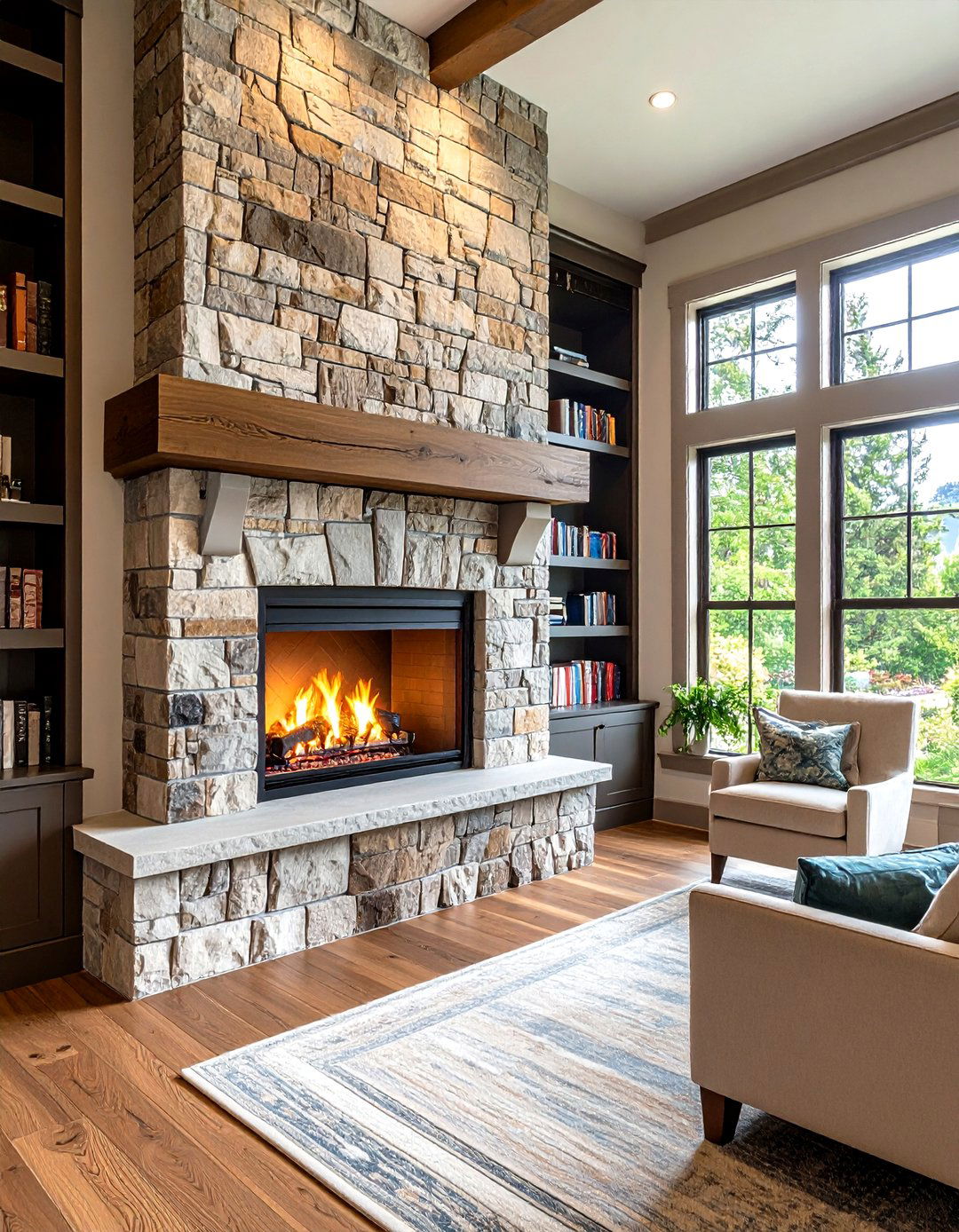
Integrating built-in shelving into a stone fireplace surround adds both storage and display opportunities. Carved niches or ledges within the stone masonry can house books, artwork, or media equipment, keeping the room organized while showcasing personal items. This approach blends form and function—stone ensures durability and heat resistance, while shelves provide practical storage. Wood-framed niches soften the stone’s solidity, introducing warmth and contrast. Concealed lighting within shelves highlights décor pieces and accentuates the stone’s natural textures after dusk.
13. Mixed-Material Mantel
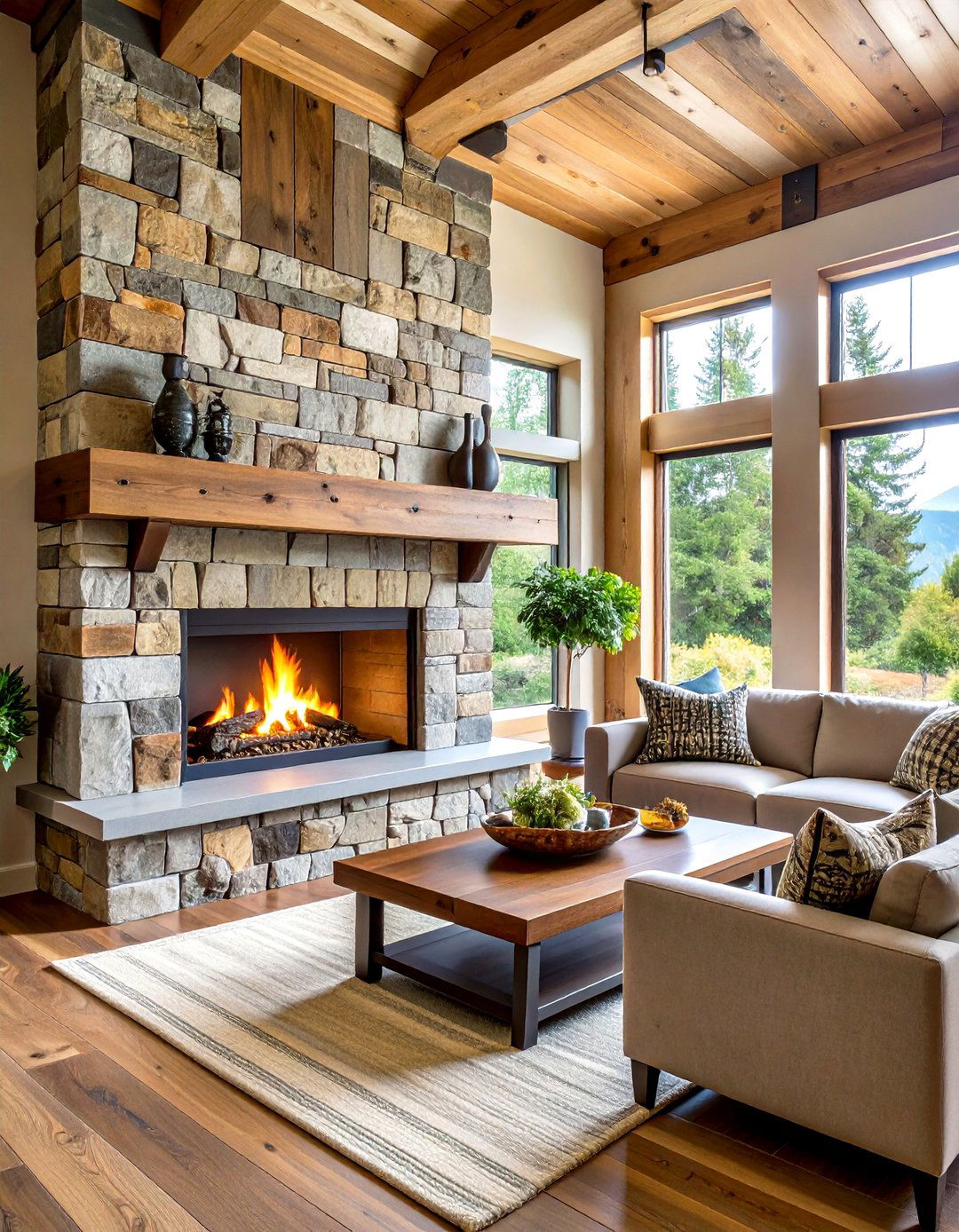
Combining a heavy wooden beam mantel with a stone surround creates dynamic visual contrast. The raw grain of reclaimed wood enhances the rugged stone facade, fostering an inviting, tactile environment. Mantel beams can span the full width of the fireplace or cantilever outward for a floating effect. Metal brackets or leather straps add industrial flair. This mixed-material strategy pairs well with open shelving and neutral furnishings, balancing the hearth’s weighty presence with modern, airy décor elements.
14. Minimalist Linear Gas Insert

Linear gas fireplaces set within a flat stone wall deliver sleek, contemporary appeal. Long, narrow fireboxes emphasize horizontal lines, complementing minimalist décor. Surrounding the insert with uniform stone panels—either natural slate or limestone—reinforces the design’s clean aesthetic. Heat-resistant glass doors and edge-to-edge framing ensure safety and unobstructed views. Remote controls and adjustable flame settings offer convenience, while recessed dimmable lighting above the firebox showcases stone textures at night.
15. Stone Fireplace with Wood Storage Niche
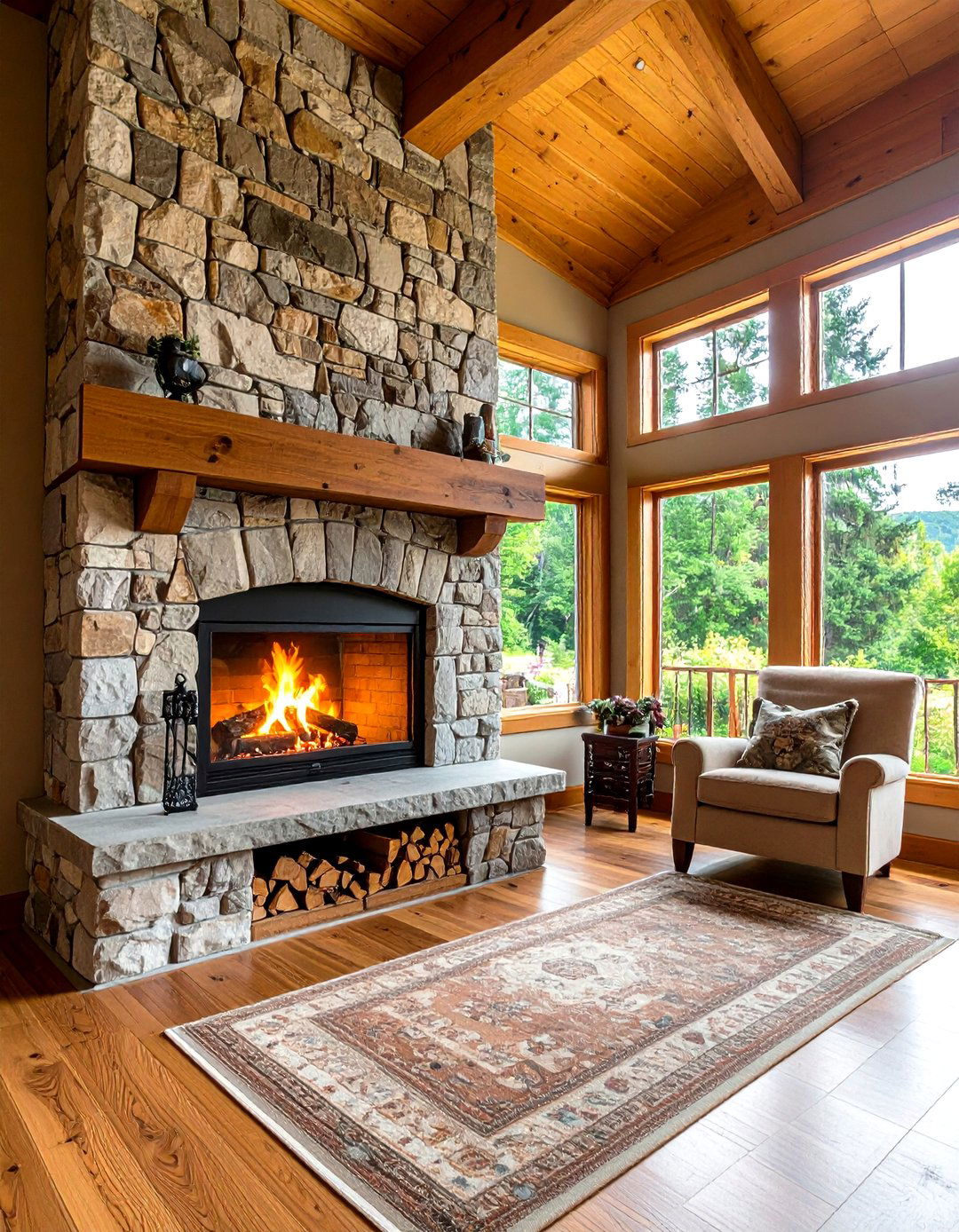
Incorporating a wood storage niche directly into the stone surround streamlines fireplace accessories. A recessed compartment beneath the hearth or alongside it provides a dedicated space for logs, keeping them within reach and organized. Lining the niche with contrasting brick or metal accent panels highlights the stone’s natural hues. This functional feature reduces floor clutter and emphasizes the rustic charm of a stone hearth, ideal for homes prioritizing both aesthetics and practicality.
16. Travertine Tile Surround
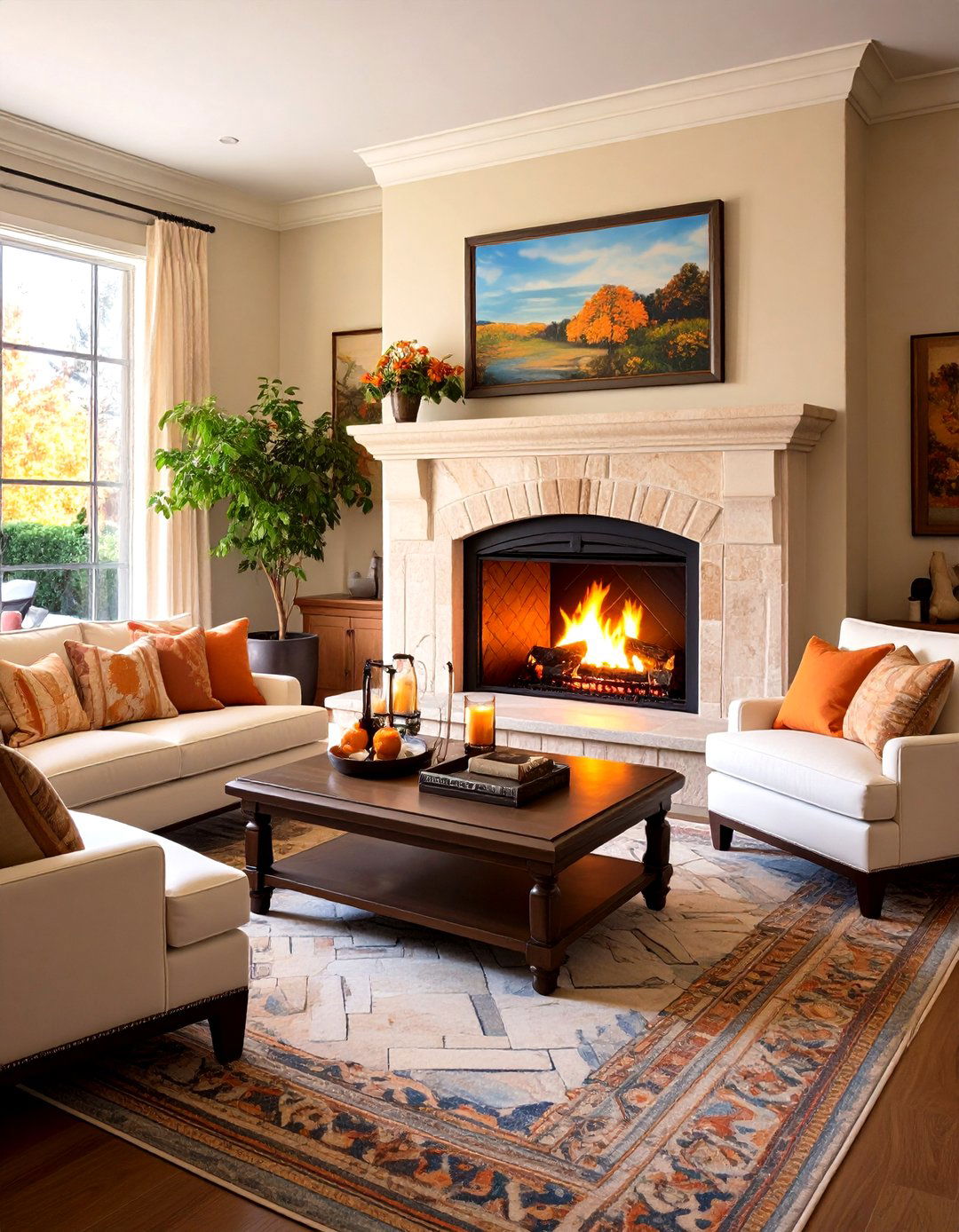
Travertine tiles offer a refined, lighter-toned stone option for fireplace surrounds. Their subtle veining and pitted surface lend a classic Mediterranean elegance when installed in herringbone or subway patterns. Because travertine is a softer form of limestone, it requires sealing and is best paired with gas fireplaces to avoid thermal stress. Its warm beige palette complements dark wood floors and neutral furnishings, creating a serene, sophisticated hearth without overwhelming the room’s color scheme.
17. Marble Accent Walls
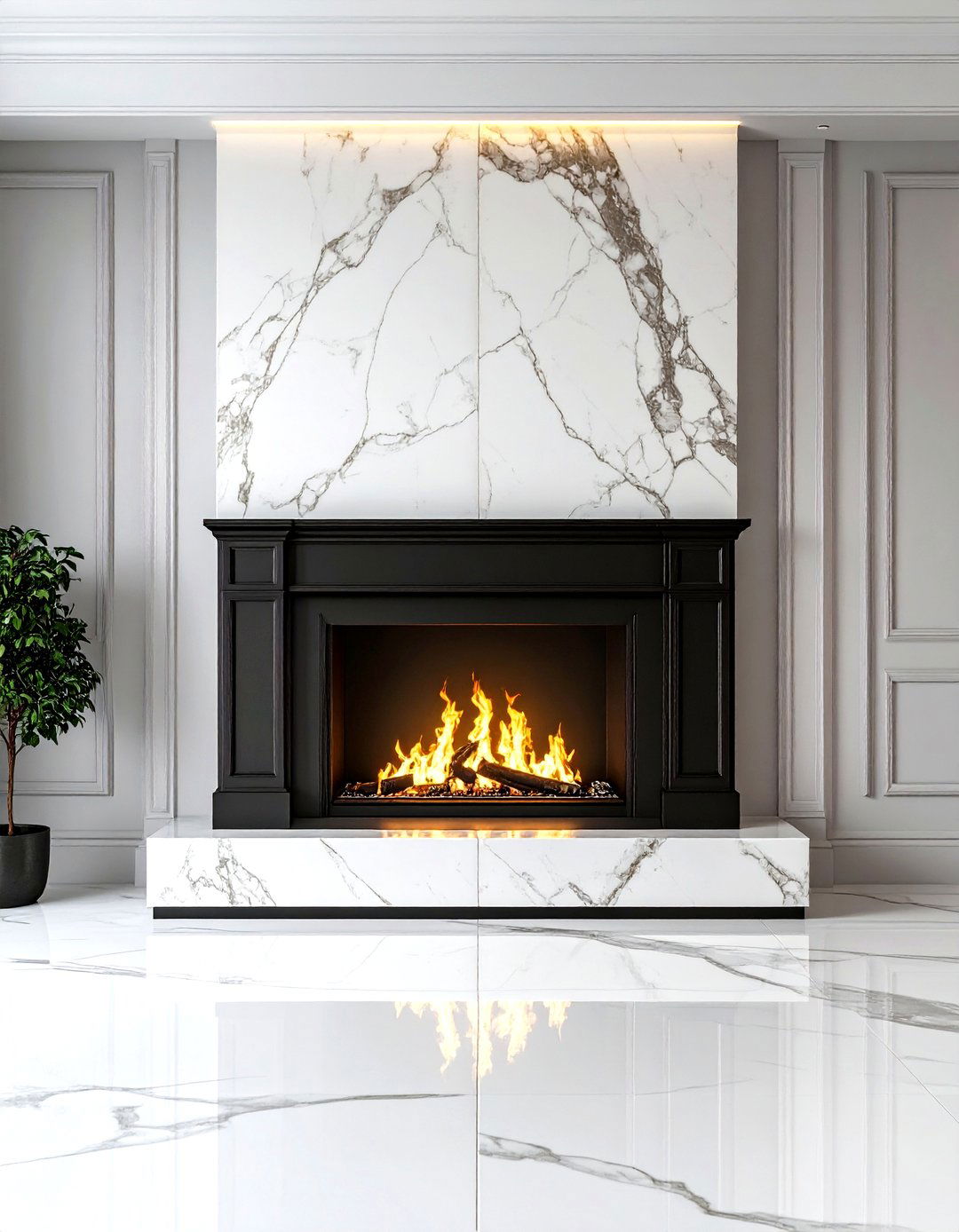
While pricier, marble accent walls elevate a fireplace into a statement piece with their luxurious veining and polished finish. Bookmatched slabs flanking a modern gas insert amplify symmetry and grandeur, often seen in high-end residential and hospitality projects. White or Calacatta marble brightens spaces, reflecting light to enhance the room’s brightness. Thinner marble veneers reduce weight but maintain visual impact, and pairing with matte black fireboxes introduces a dramatic contrast.
18. Tumbled Stone Mosaic
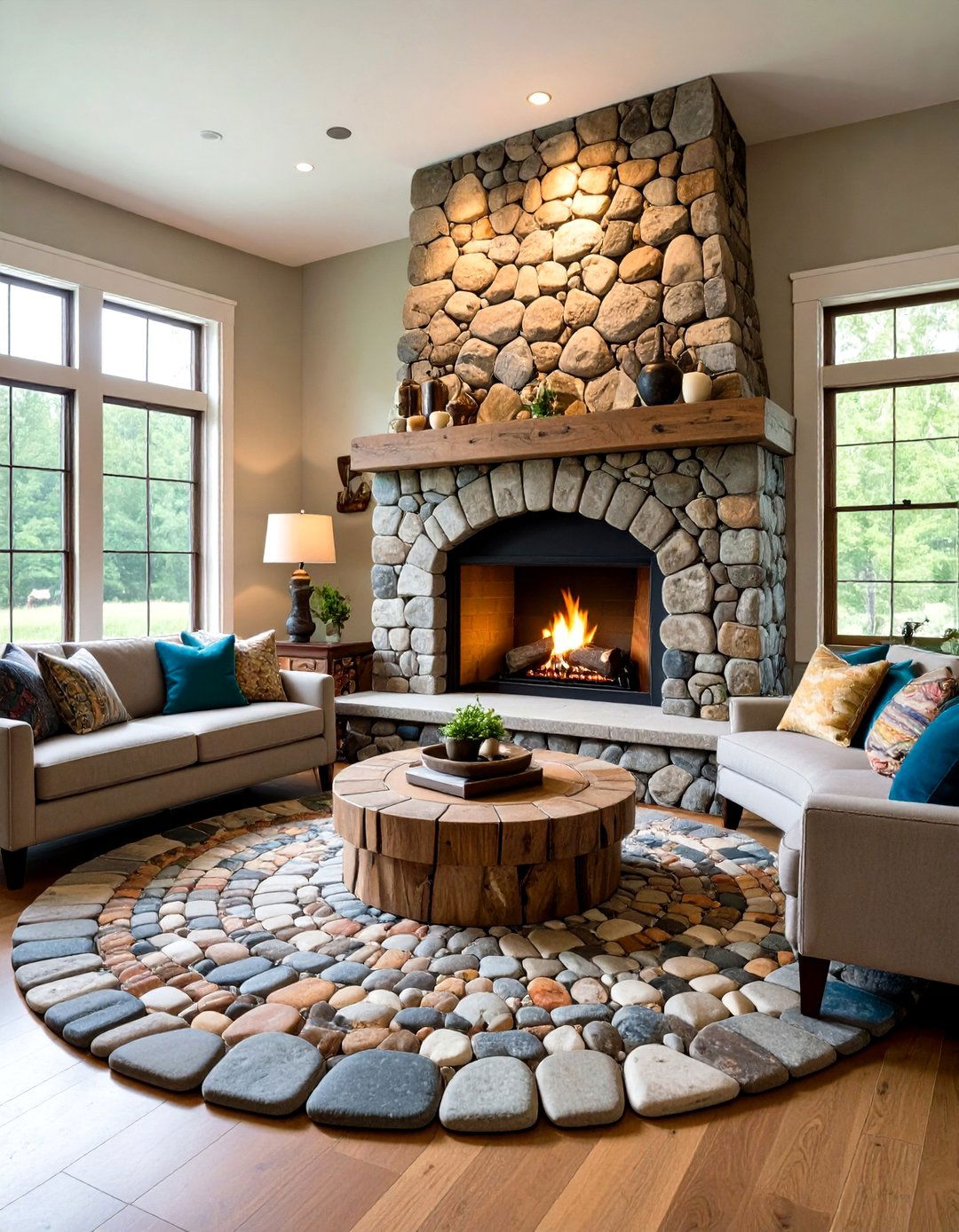
For intricate designs, tumbled stone mosaics combine small, irregular pieces into patterned surrounds. This artisanal approach yields a handcrafted look, with stones aged and softened by tumbling to reveal muted color variations. Mosaics allow for creative layouts—such as concentric circles around the hearth or staggered brick patterns—for personalized accents. Grouted joints define each stone, adding depth and shadow play. This style suits eclectic or bohemian interiors, meshing well with vintage furnishings and layered textiles.
19. Oversized Hearth with Seating Ledge
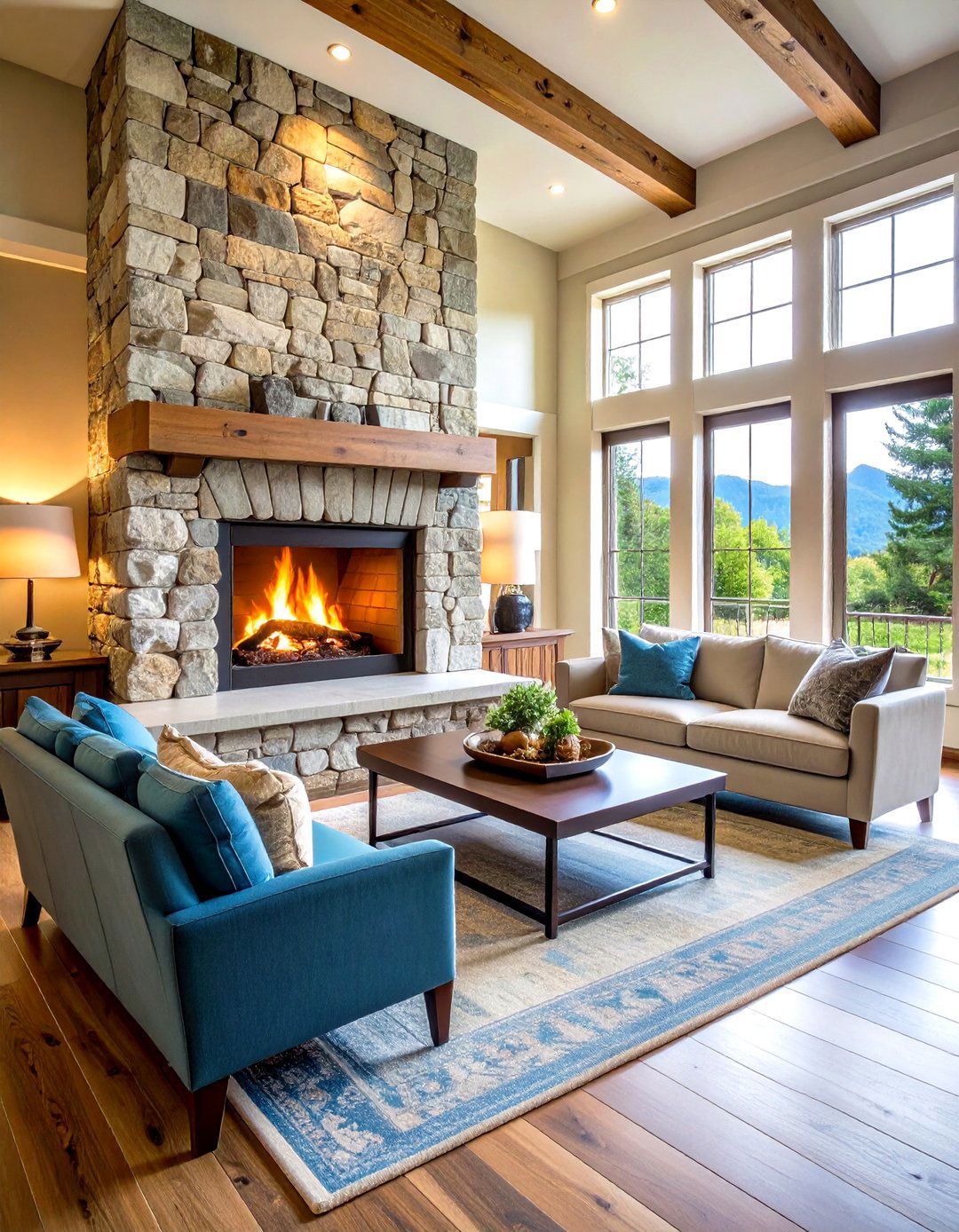
Expanding the hearth into a low, wide seating ledge creates additional seating and a casual gathering spot. Large, flat stones form a bench-like extension, inviting guests to sit close to the fire while doubling as a display area for fire tools or décor. When wrapped in the same stone as the surround, the ledge feels cohesive; contrasting materials like hardwood tops can soften the look. This design is ideal for family rooms and informal living spaces, promoting convivial lounging around the hearth.
20. Travertine and Metal Fusion
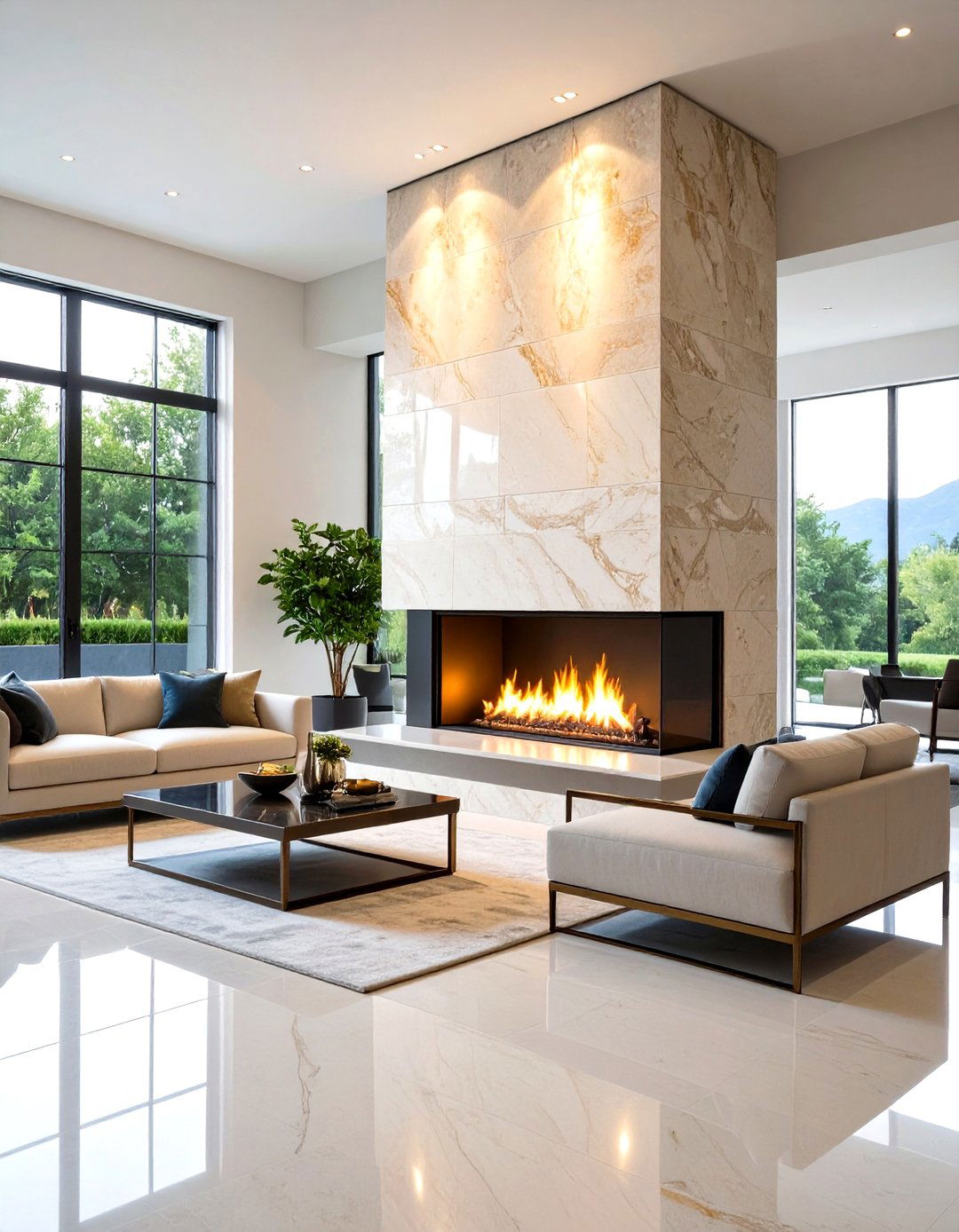
Melding travertine stone with metal accents—such as steel trim or copper panels—yields an industrial-luxe fireplace design. Metal inserts outline the hearth opening and run along curtain-wall edges, highlighting clean lines and infusing contemporary flair. Travertine’s warm tones balance the cool metallic sheen, creating harmonious tension. Integrated LED lighting behind metal reveals accentuates textures and adds depth. This fusion resonates in modern lofts and upscale urban residences seeking a bold, architecturally driven focal point.
Conclusion:
Stone fireplaces continue to captivate with their versatility, offering designs that range from rustic fieldstone hearths to refined marble surrounds and industrial-travertine fusions. By selecting appropriate materials—natural or cultured stone, slate, limestone, or travertine—and integrating functional features like built-in shelving, seating ledges, or wood storage niches, homeowners can craft personalized hearths that enhance both aesthetics and practicality. Whether installed indoors in minimalist settings or outdoors as stacked-stone gathering spots, these 20 ideas demonstrate stone’s enduring appeal as a centerpiece that brings warmth, texture, and architectural interest to any home.


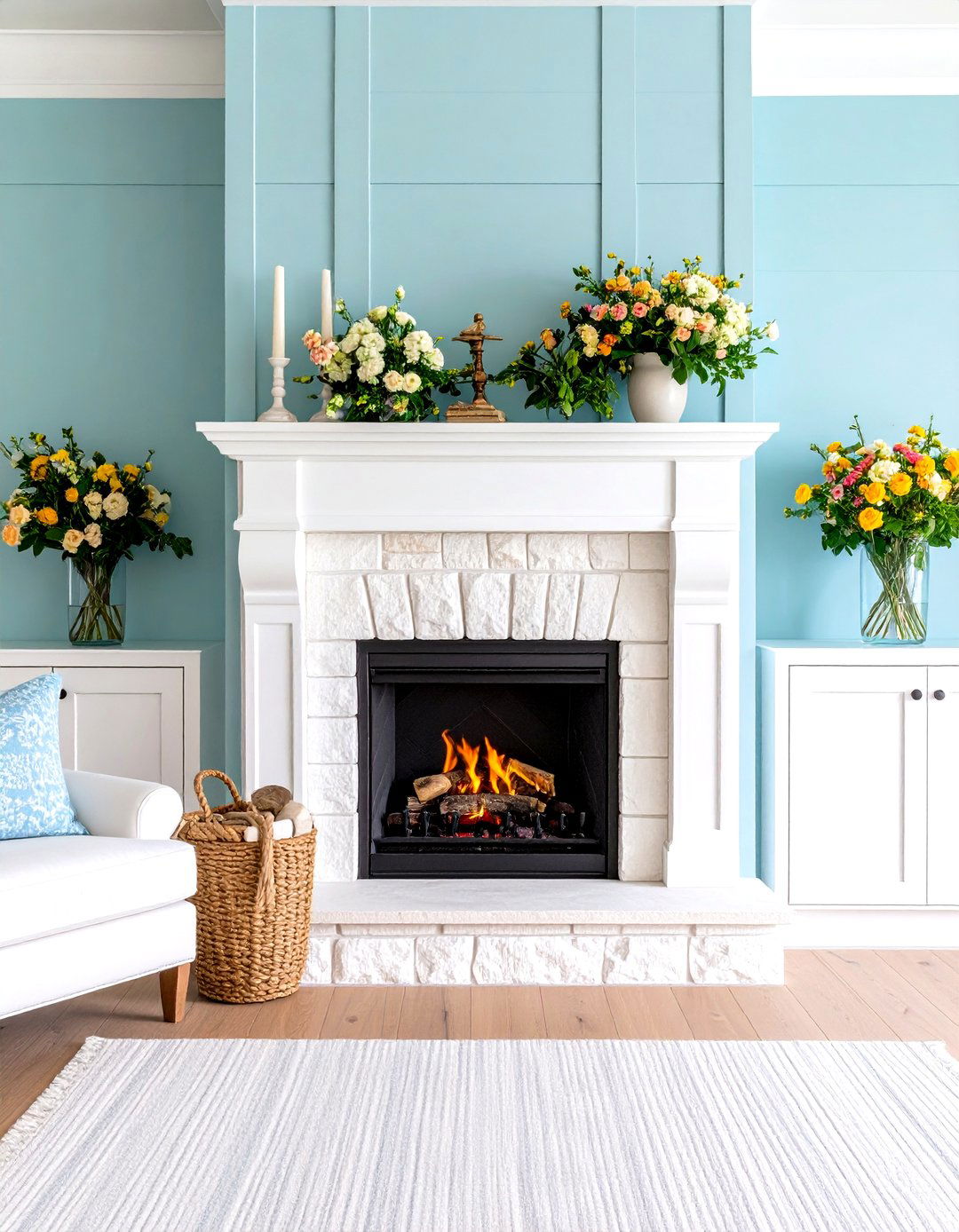
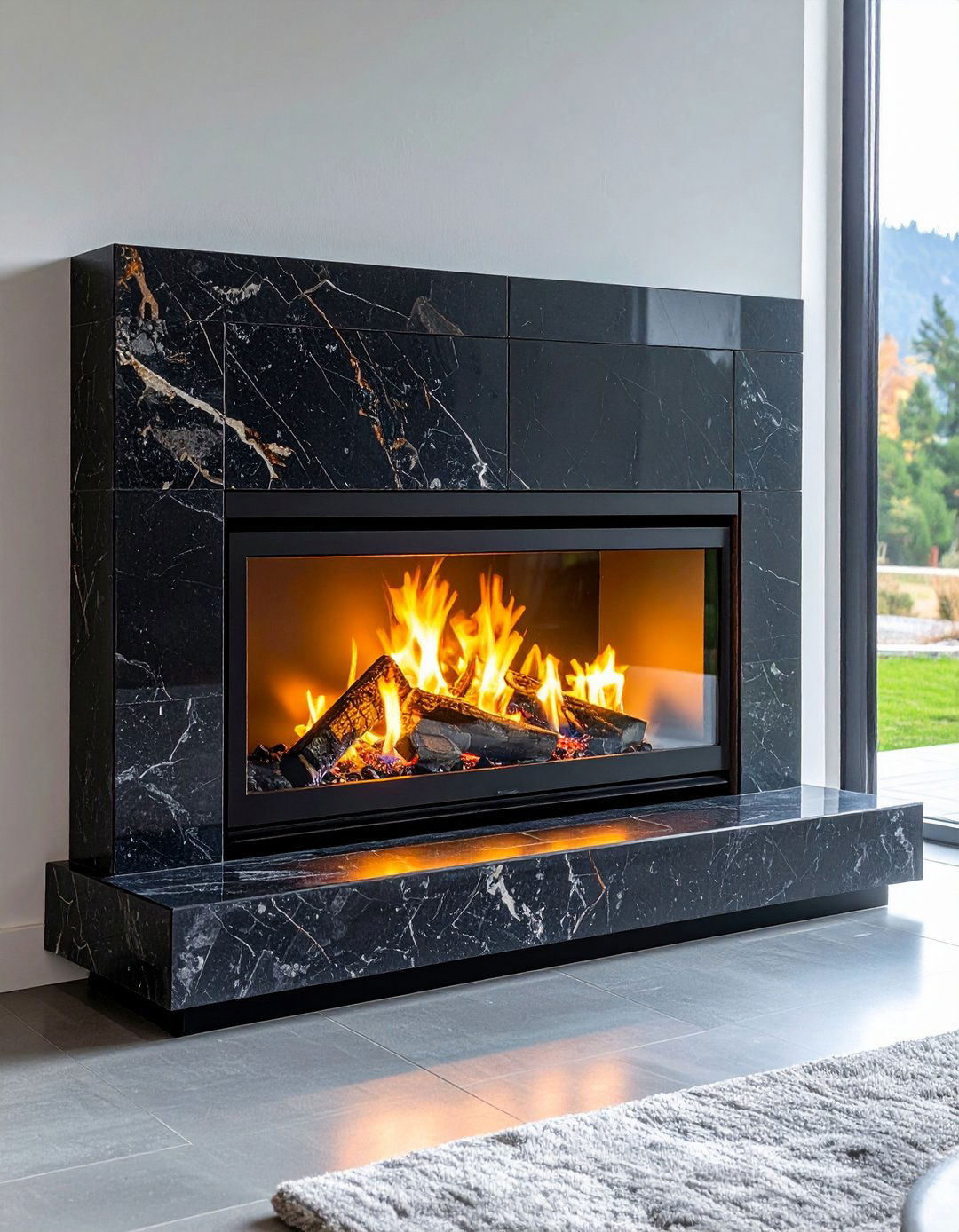
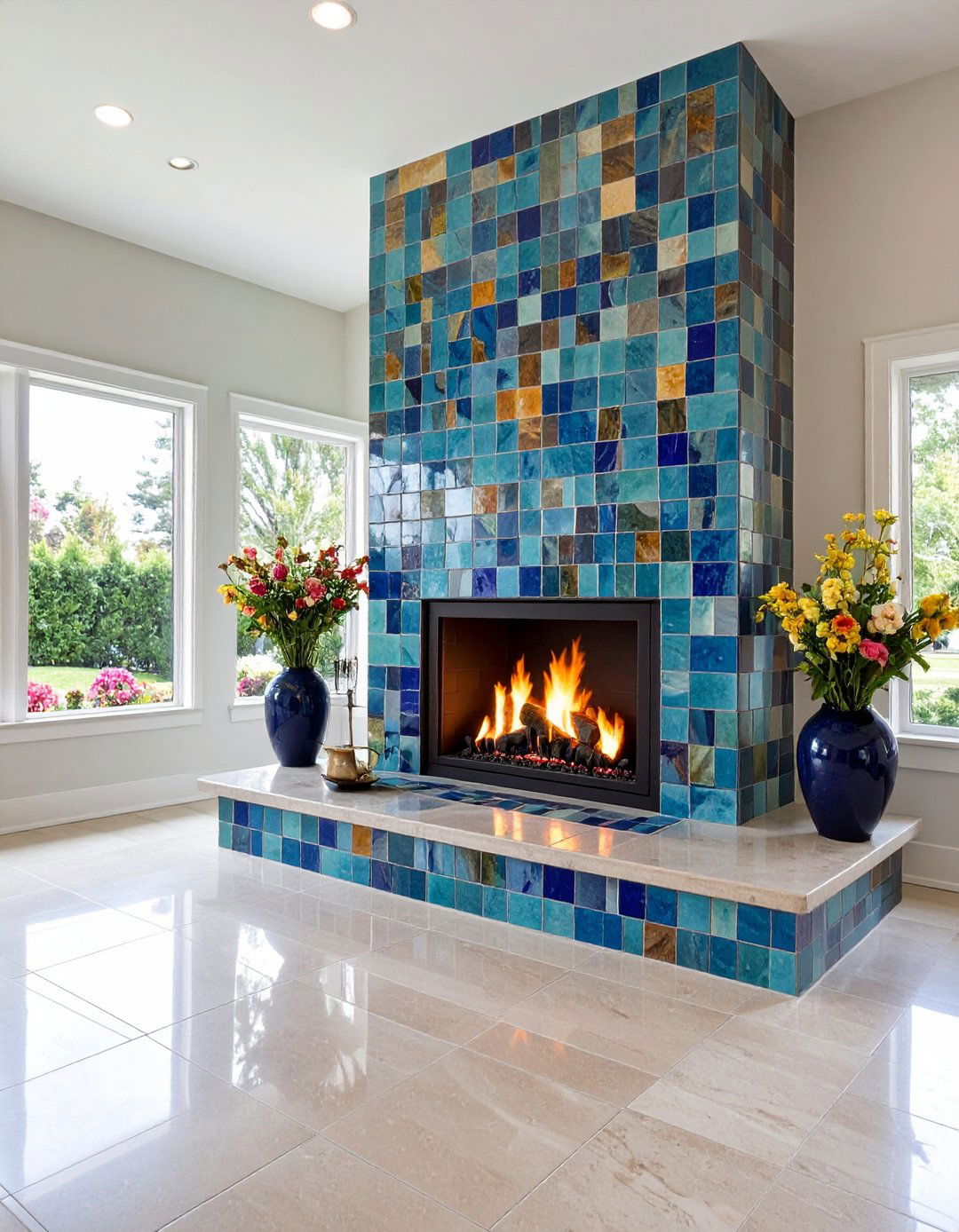
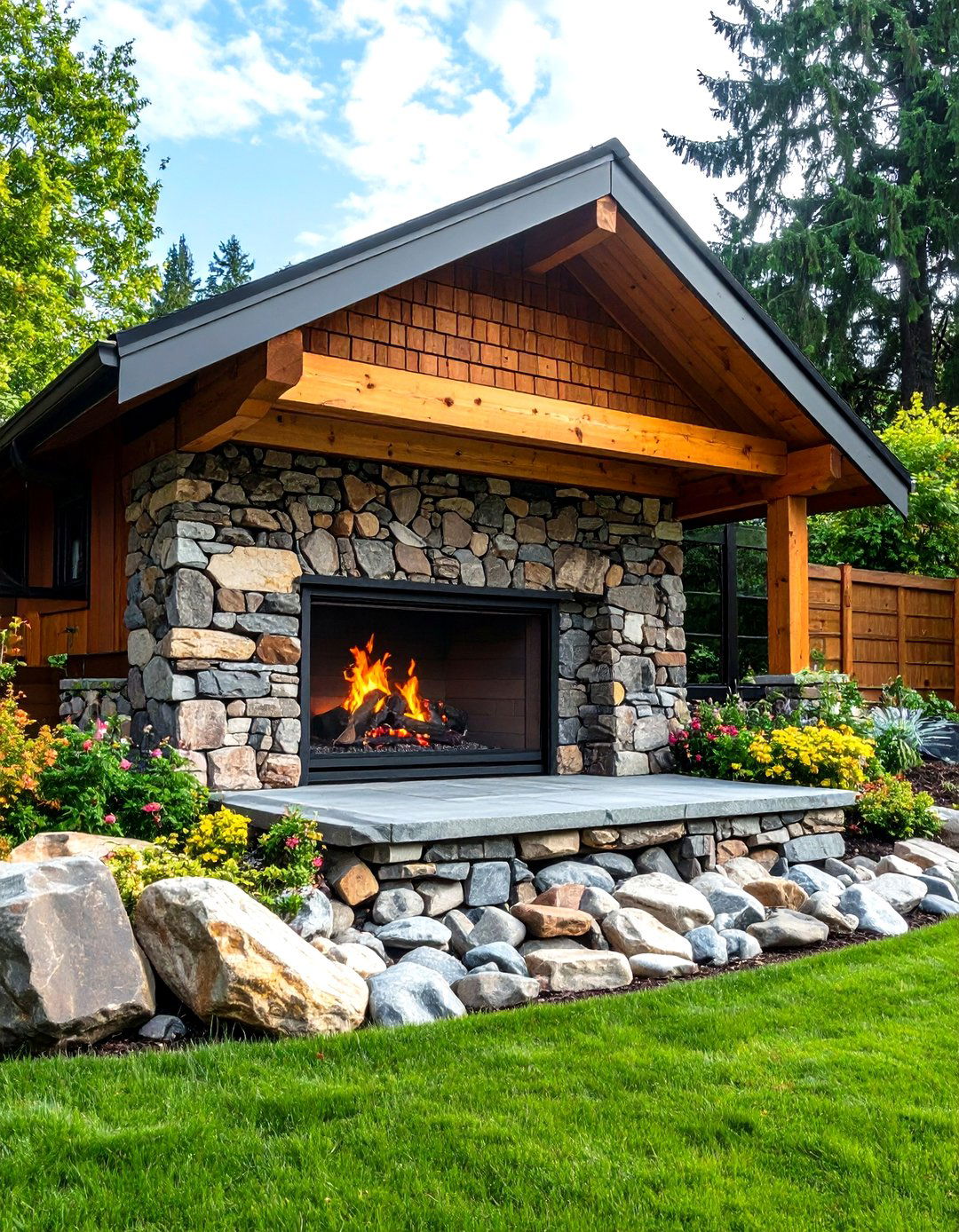
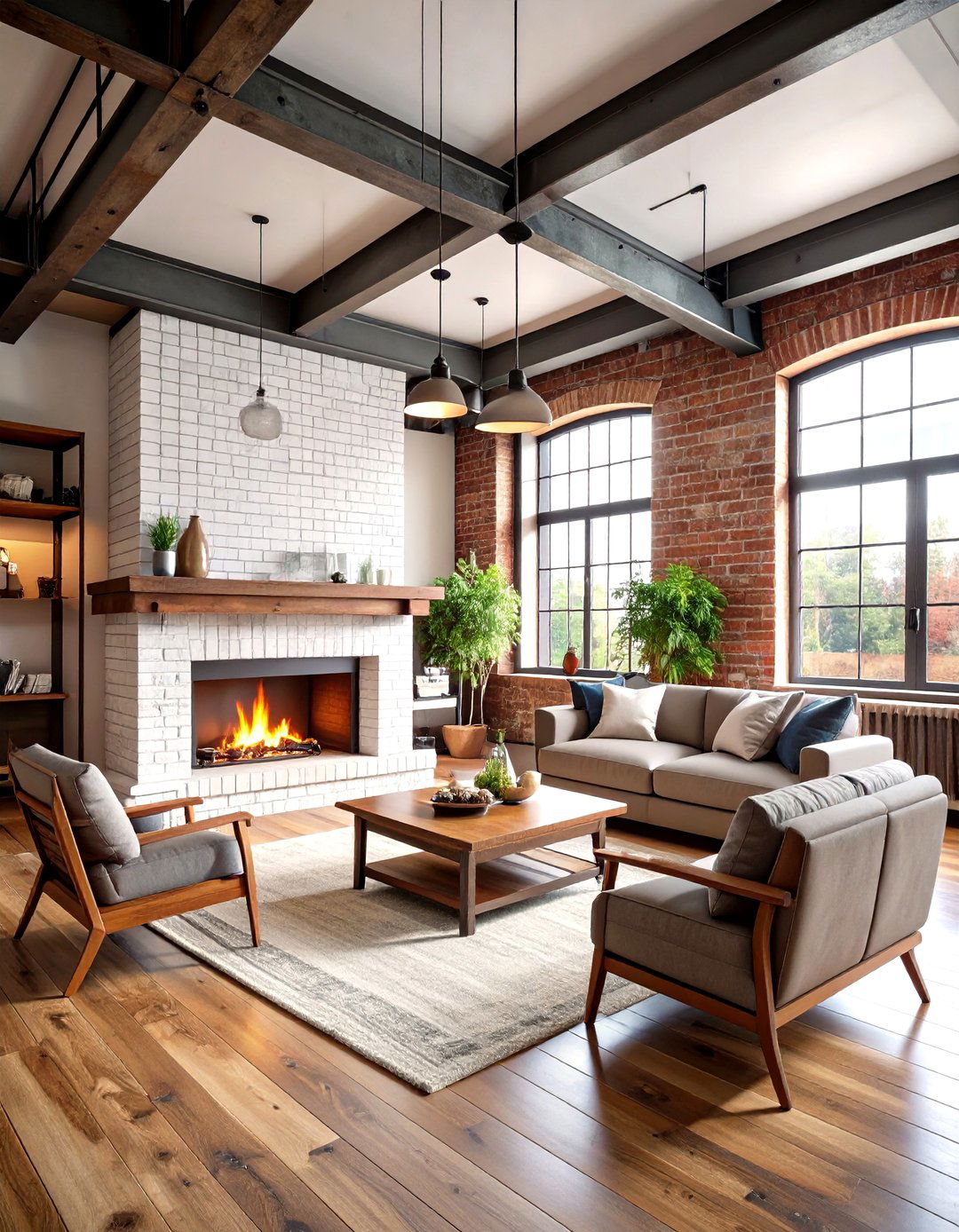
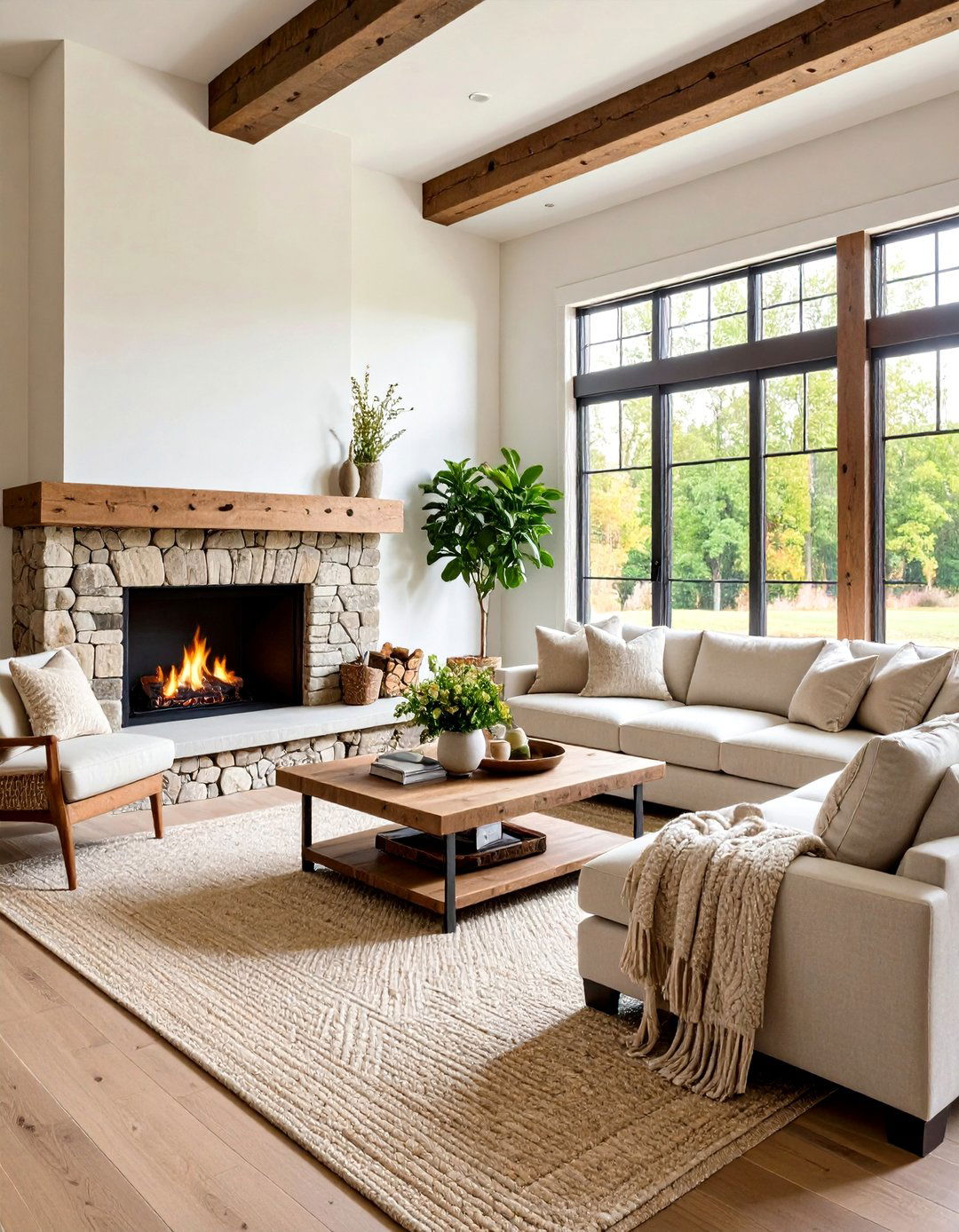
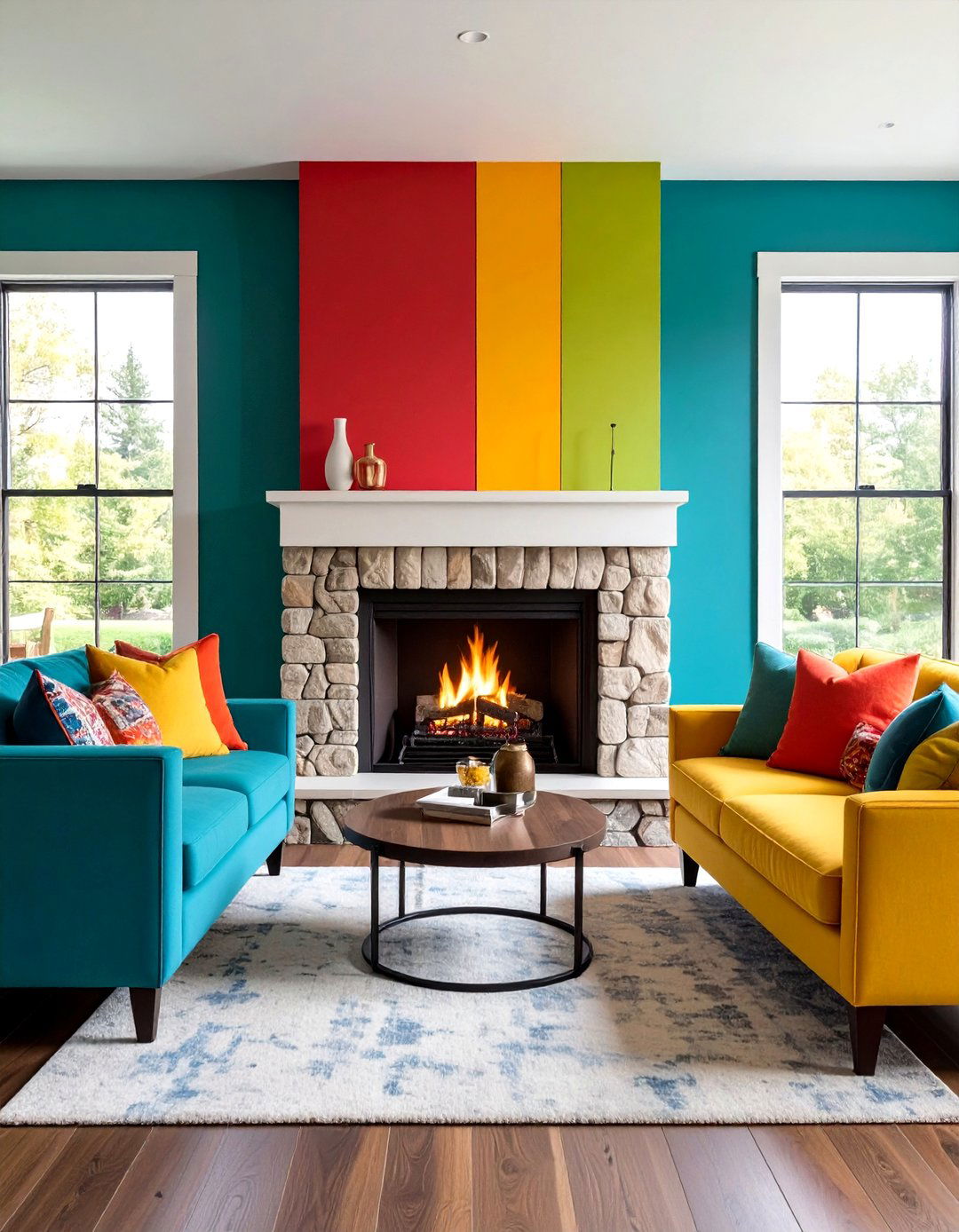
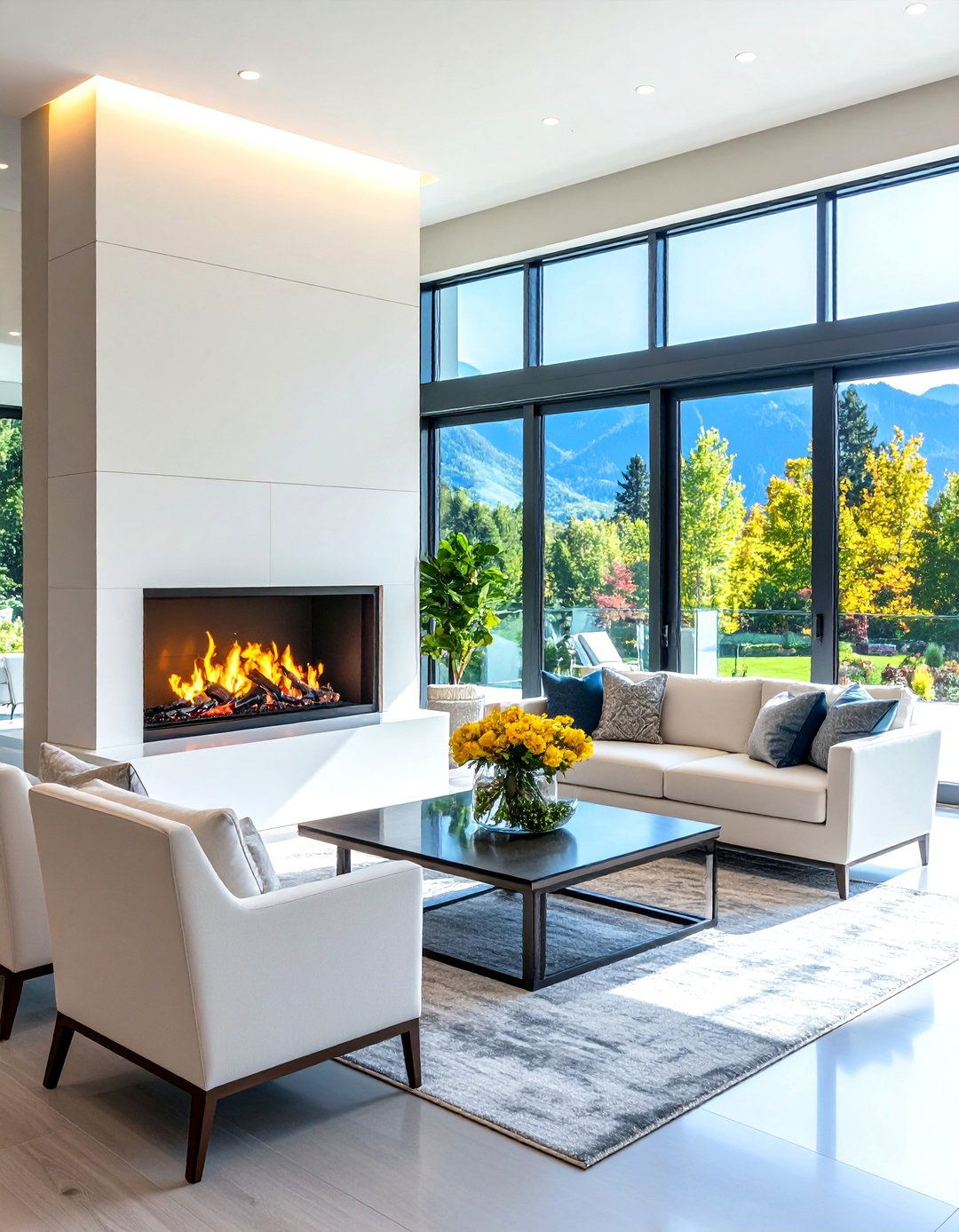

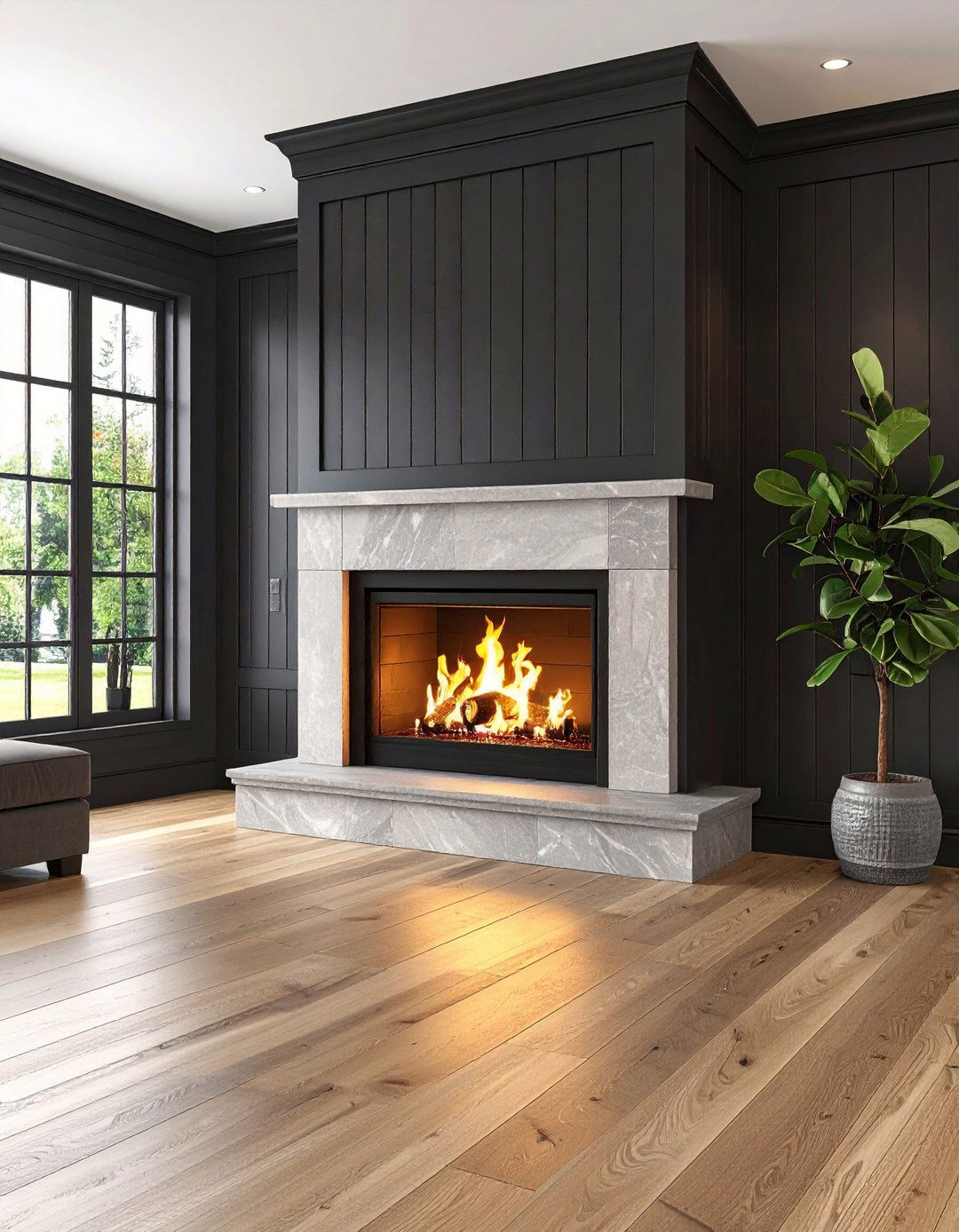
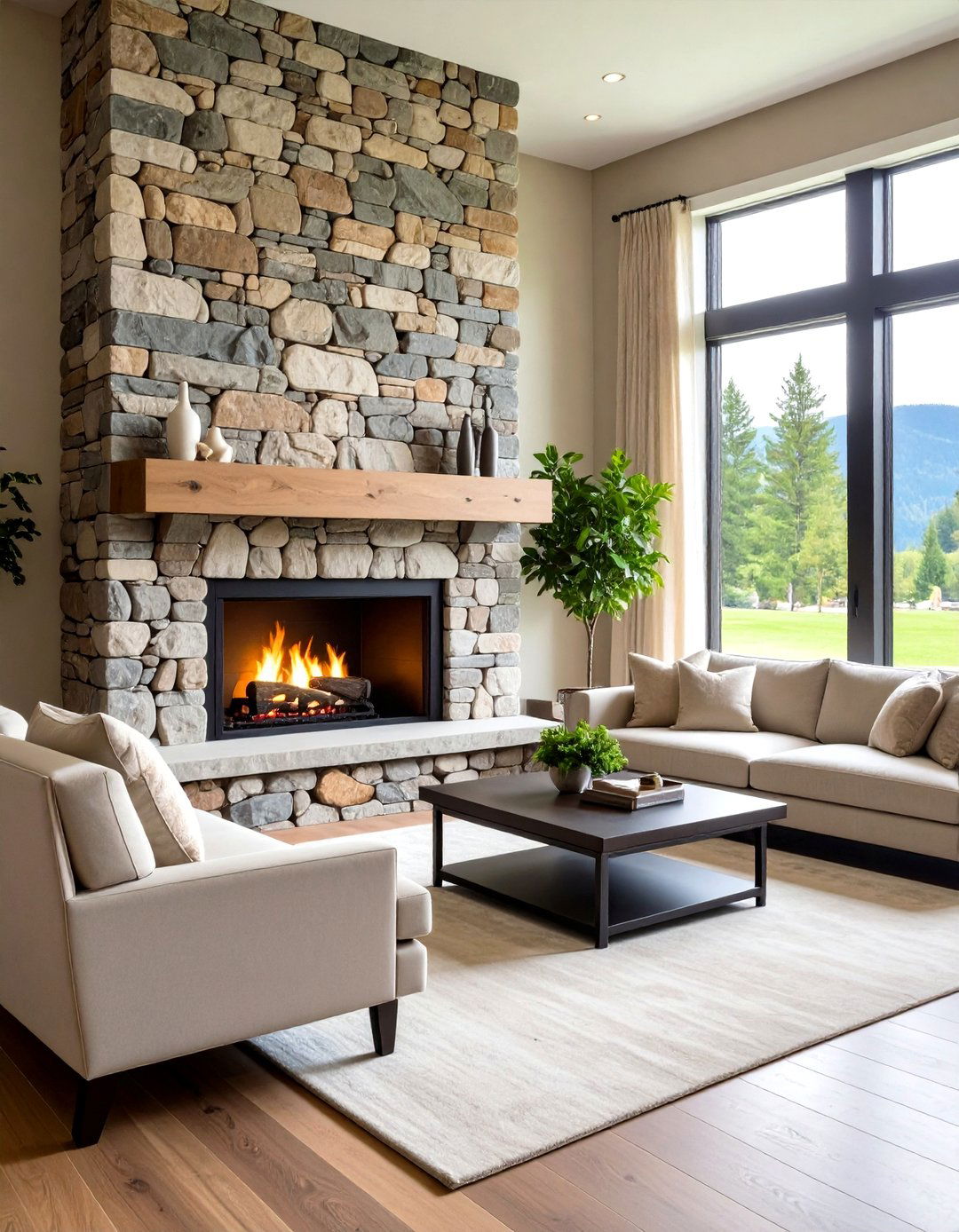
Leave a Reply